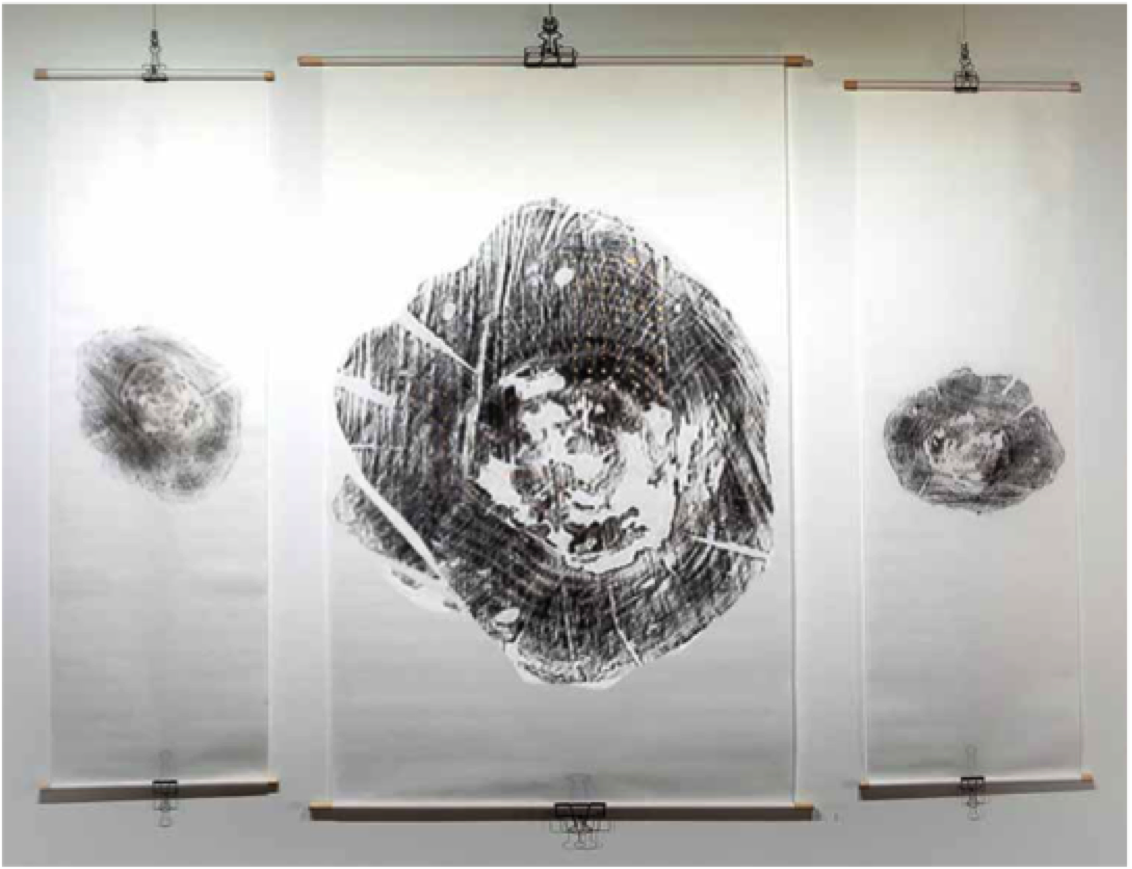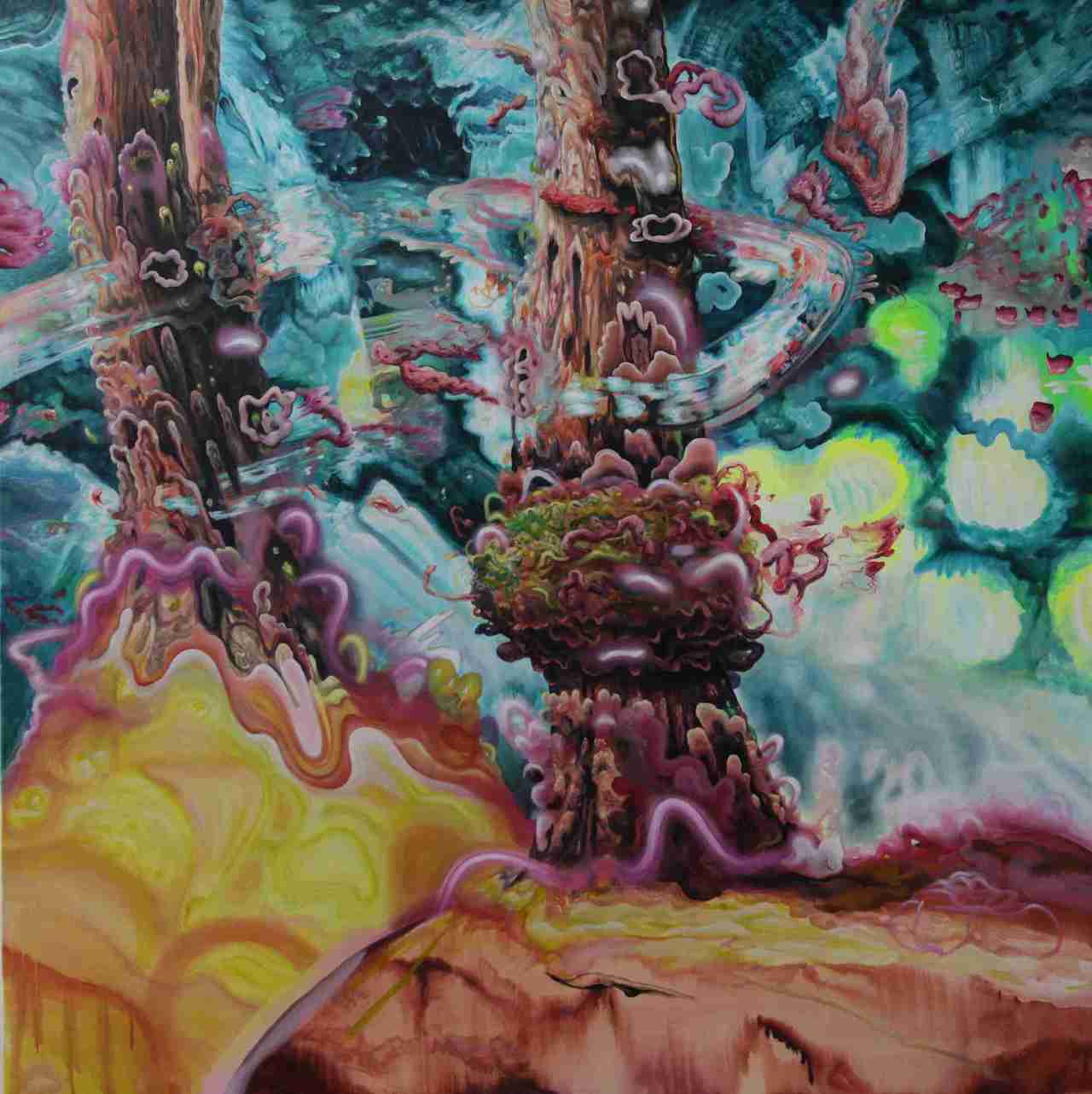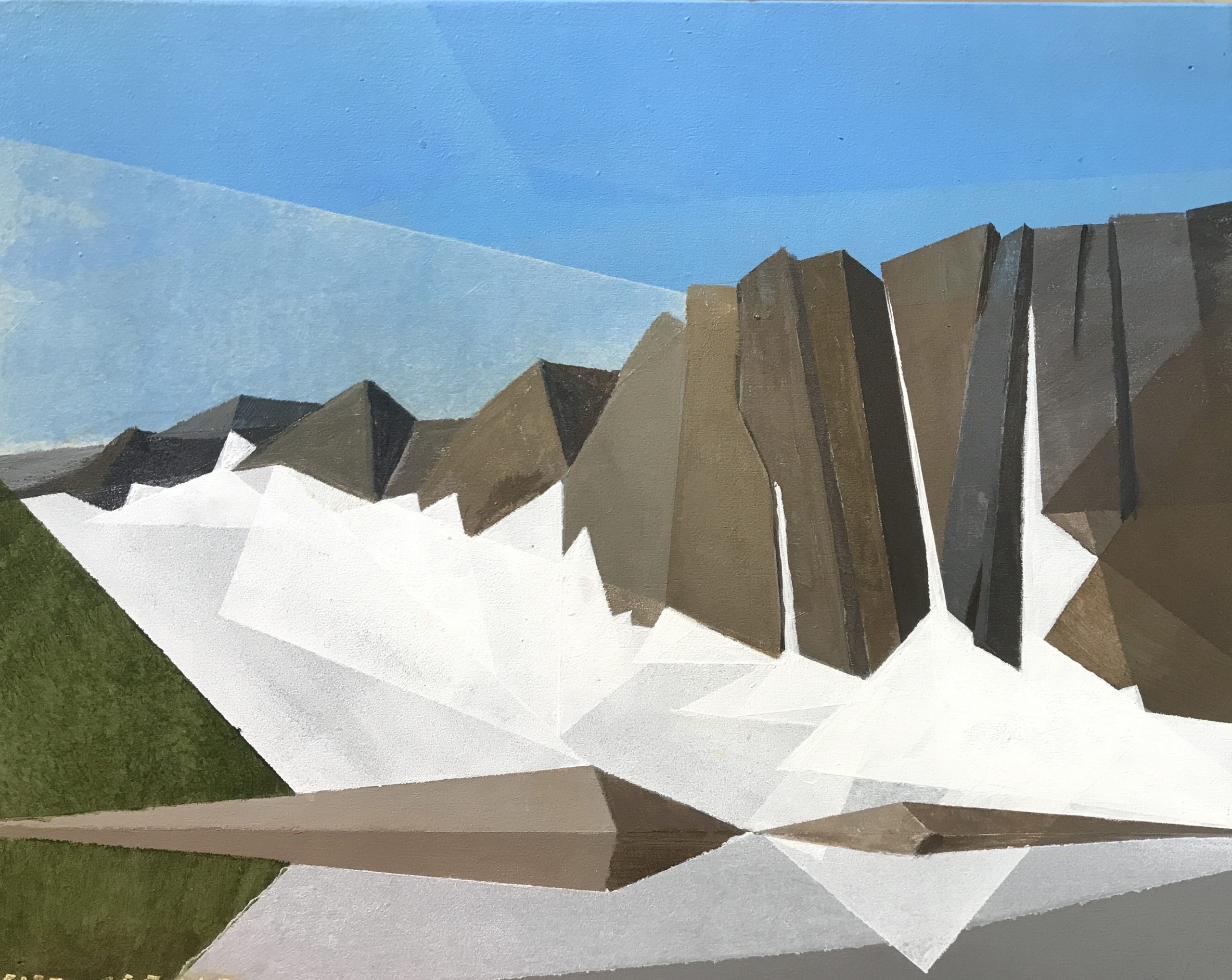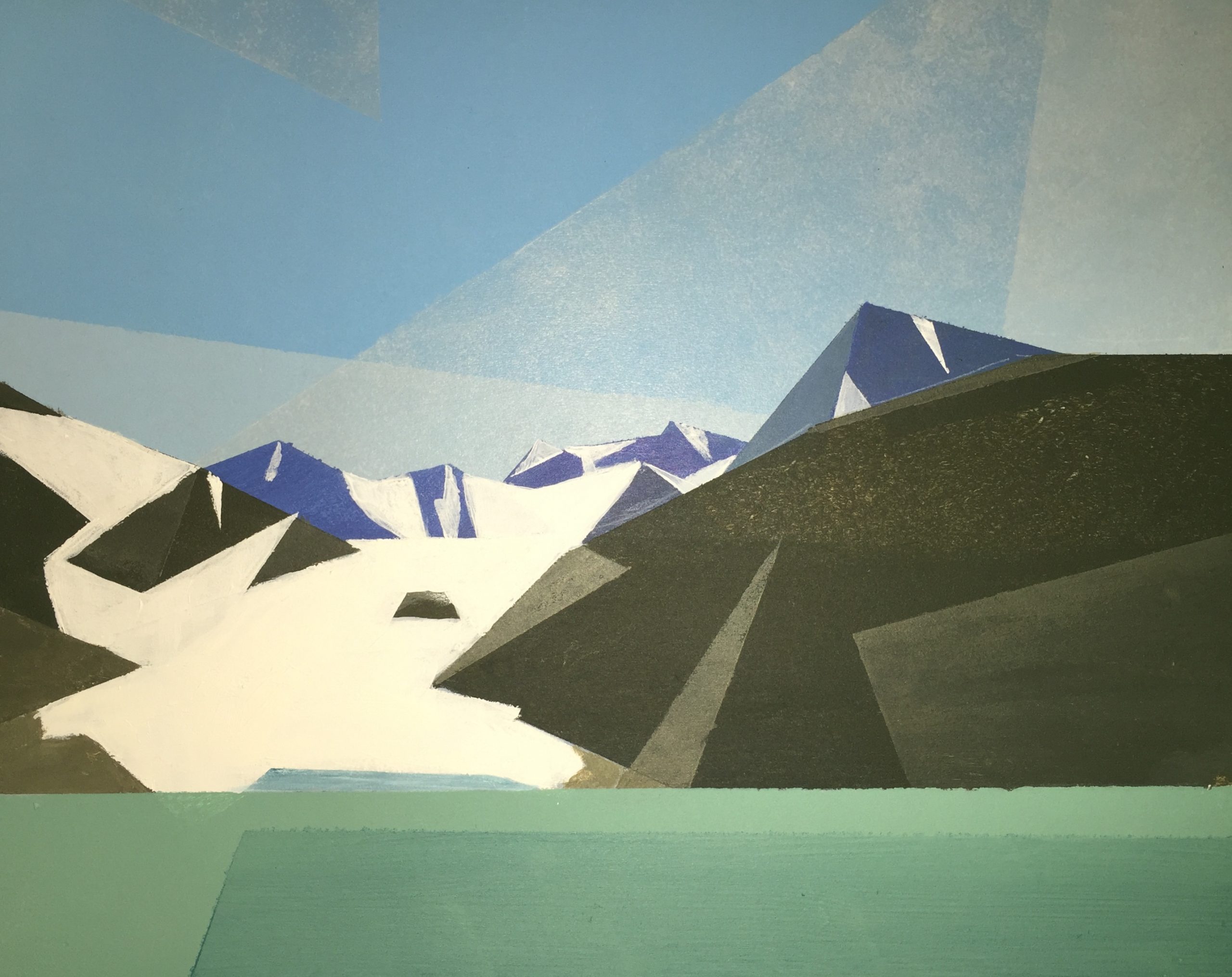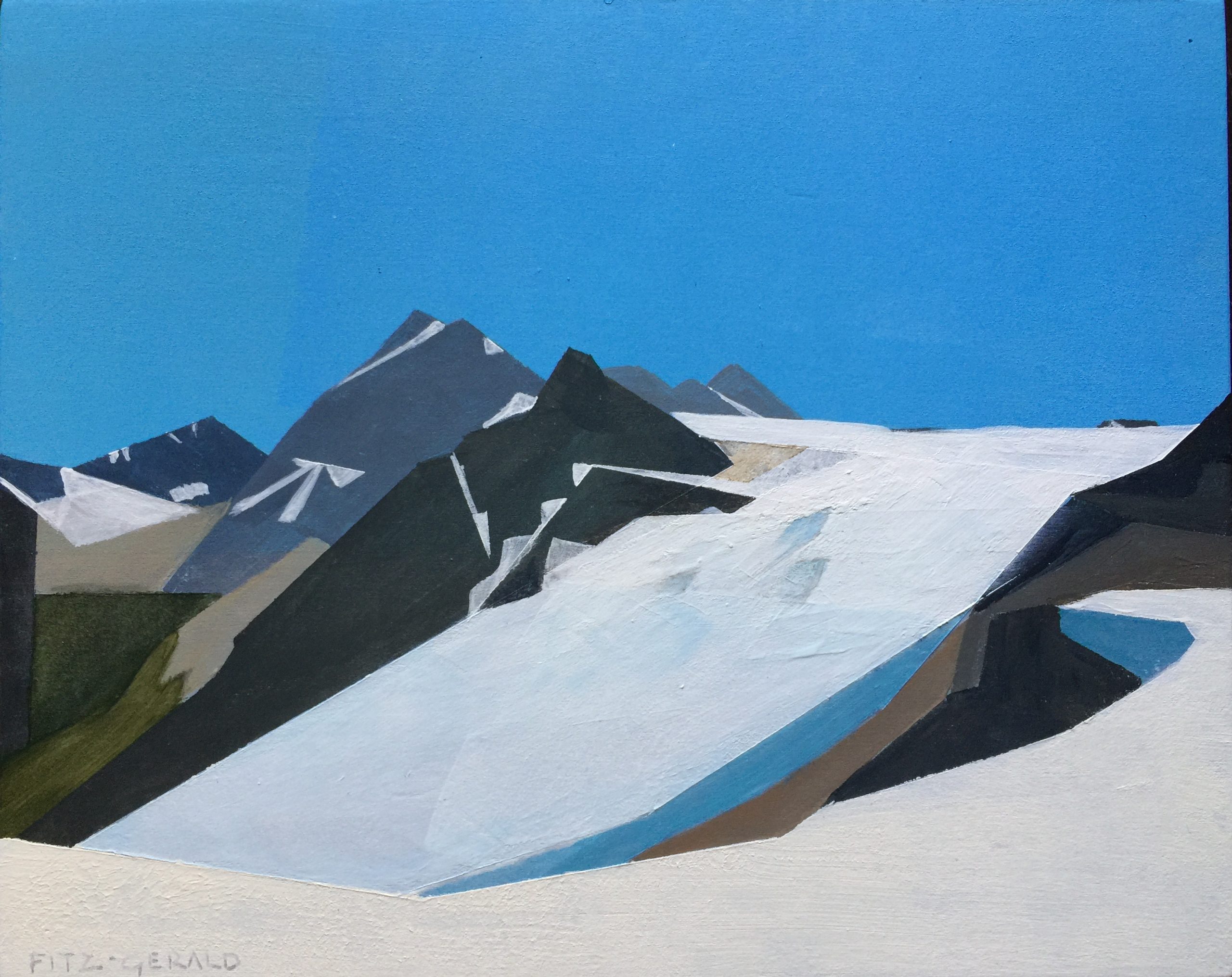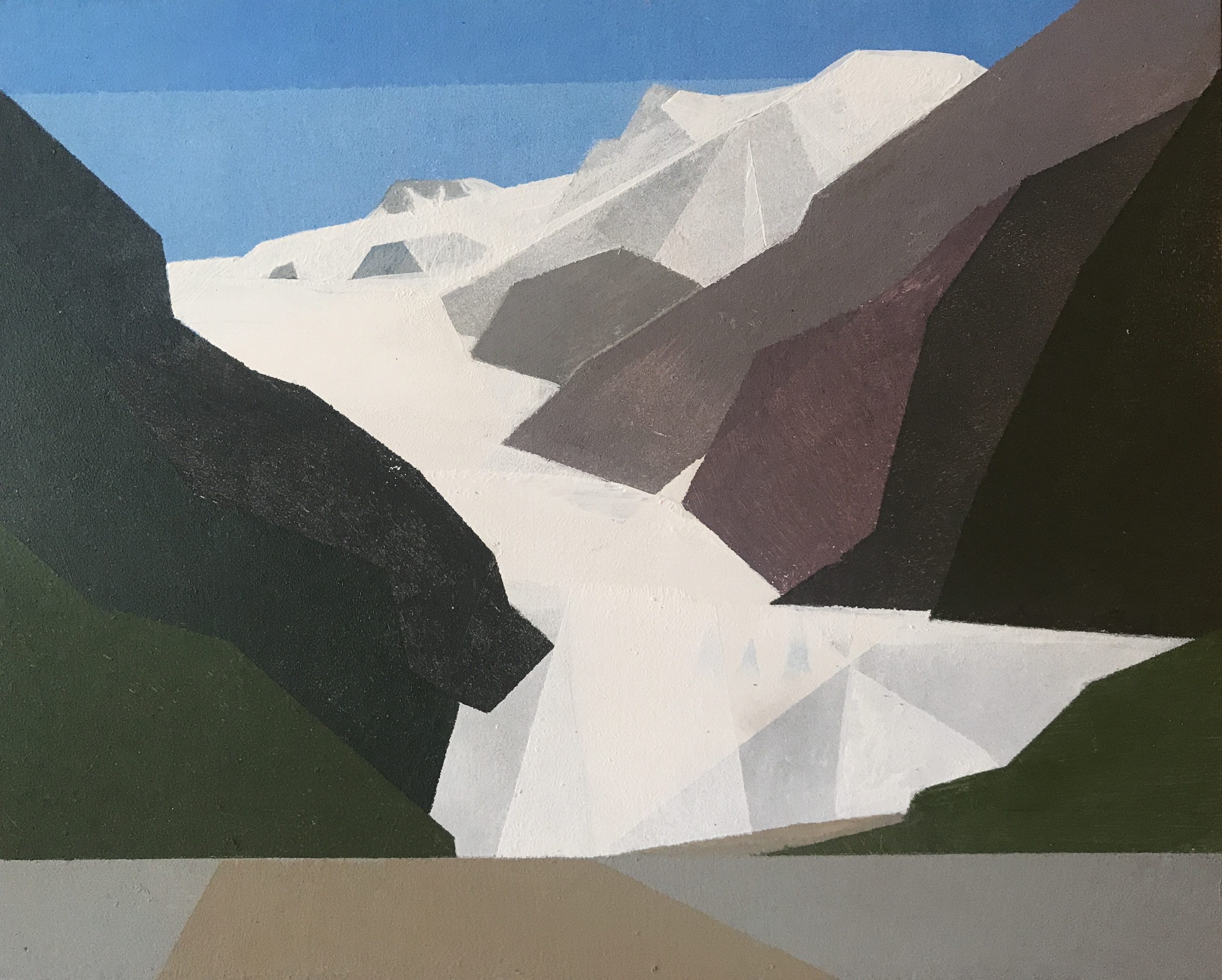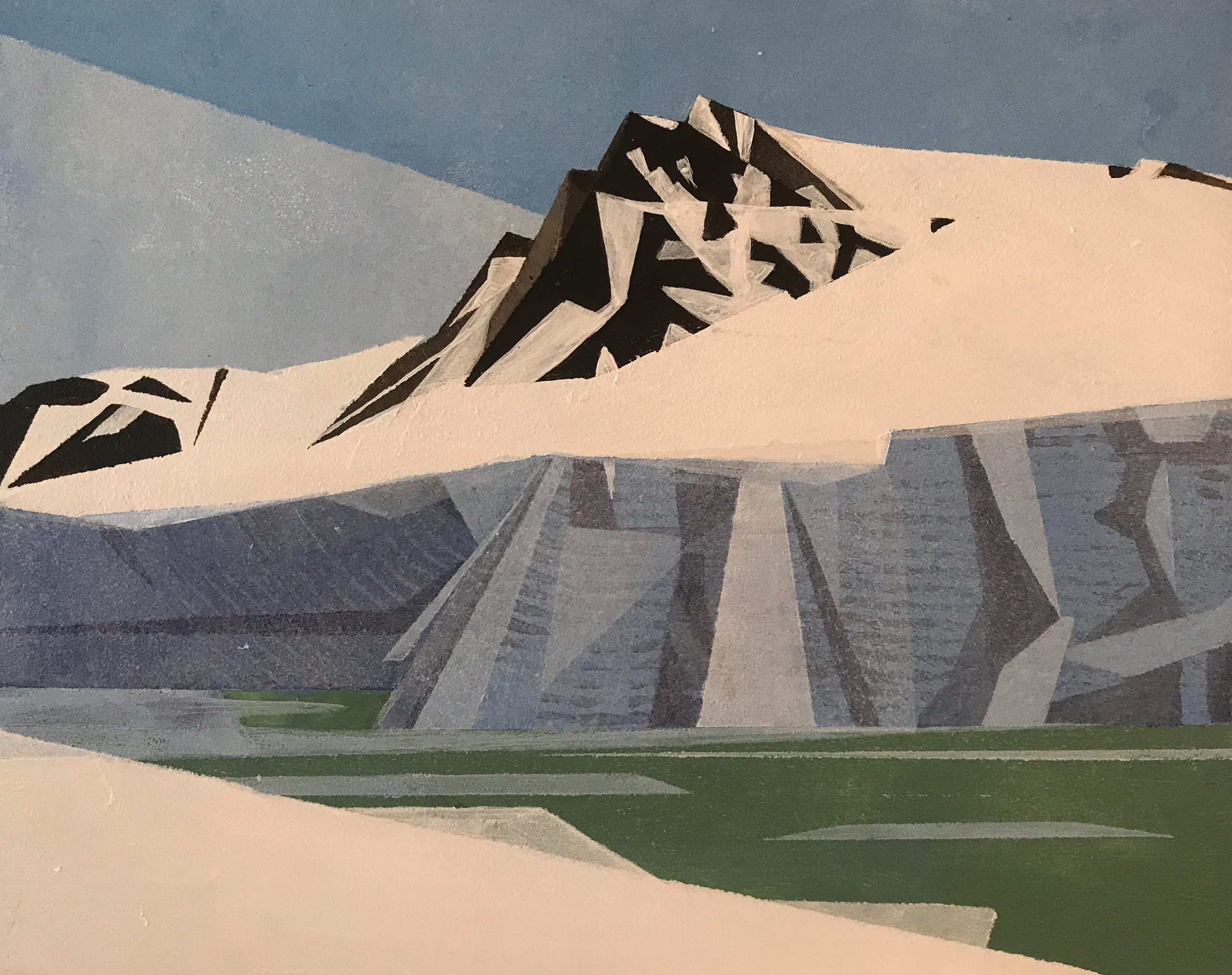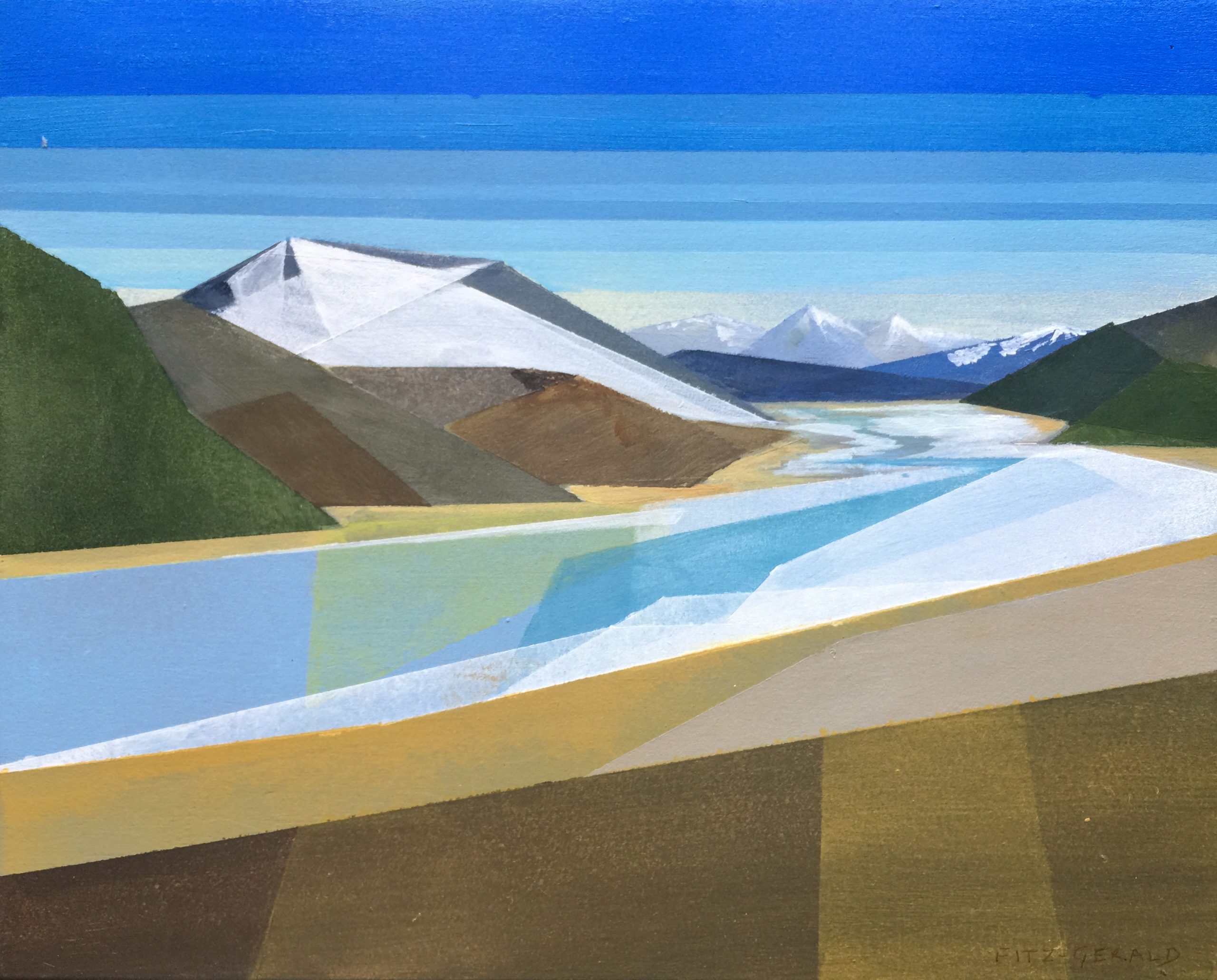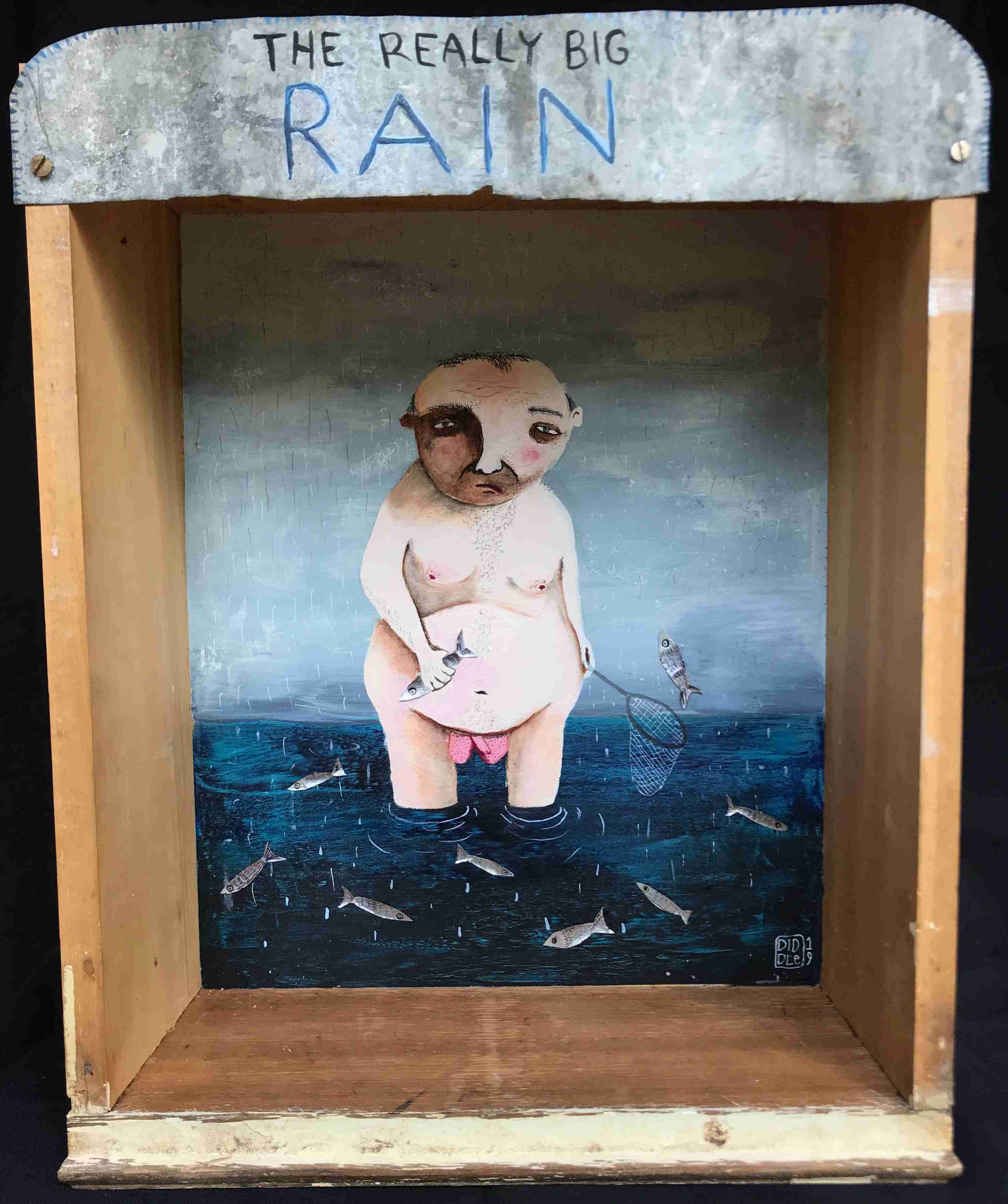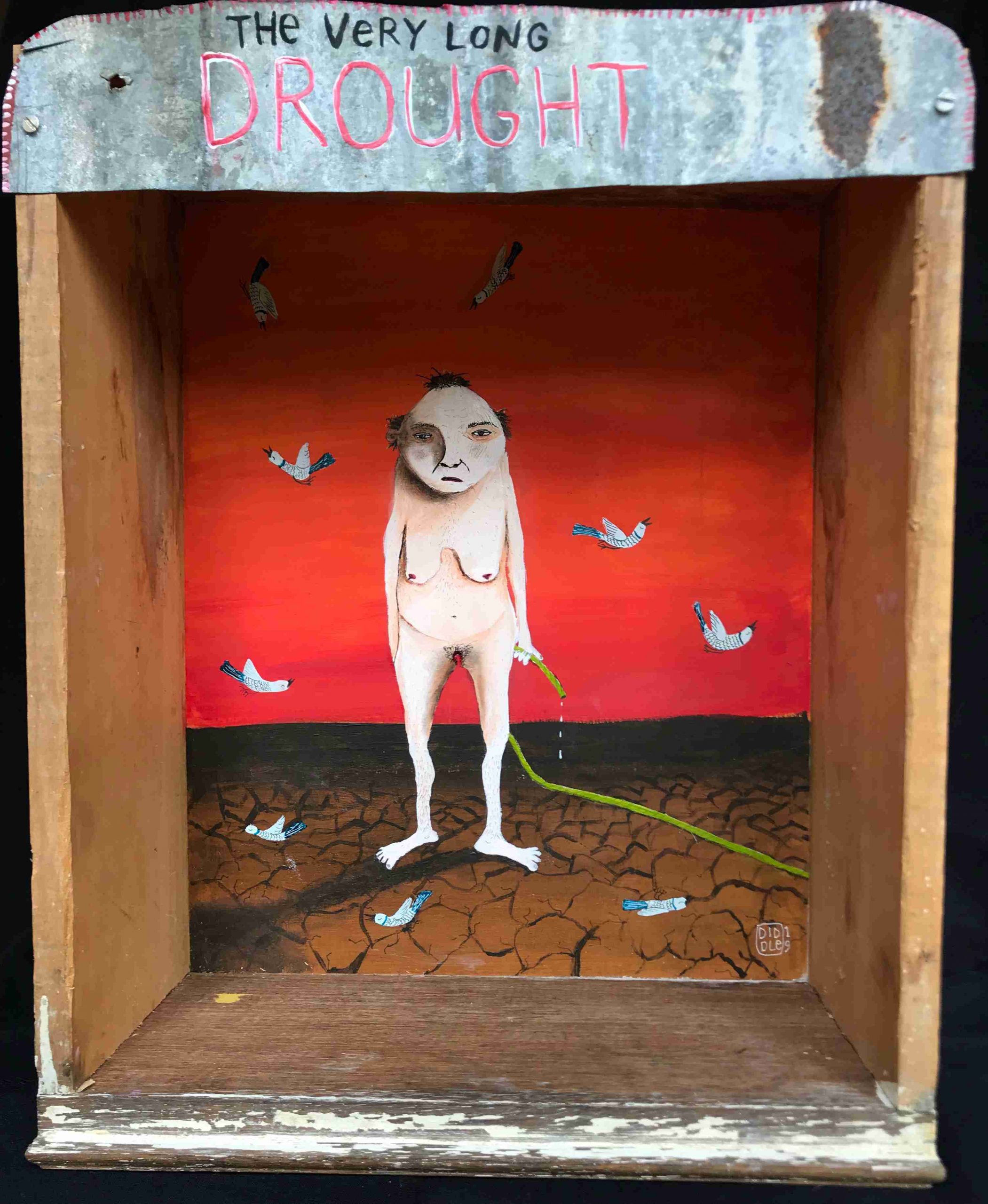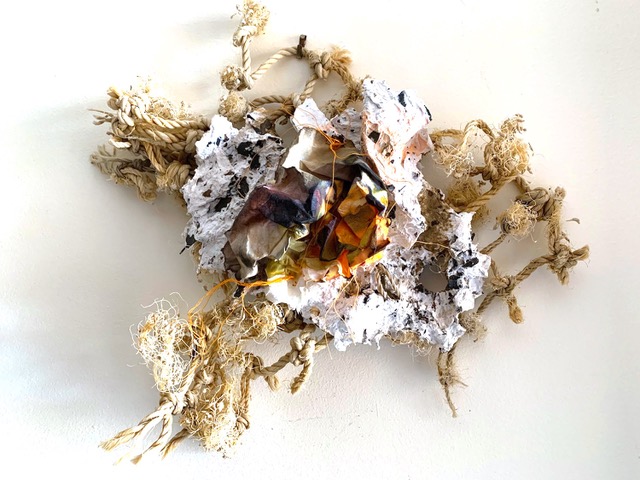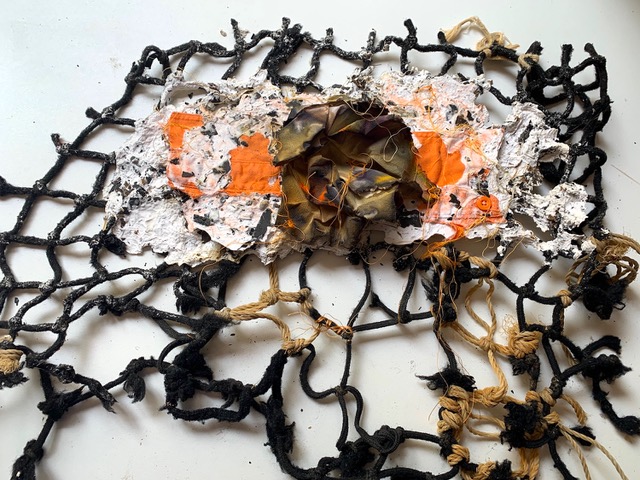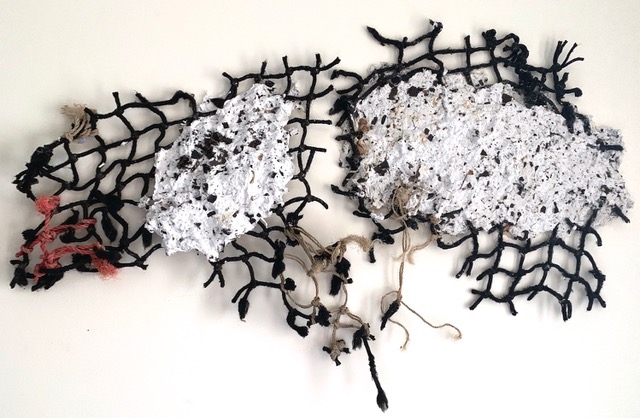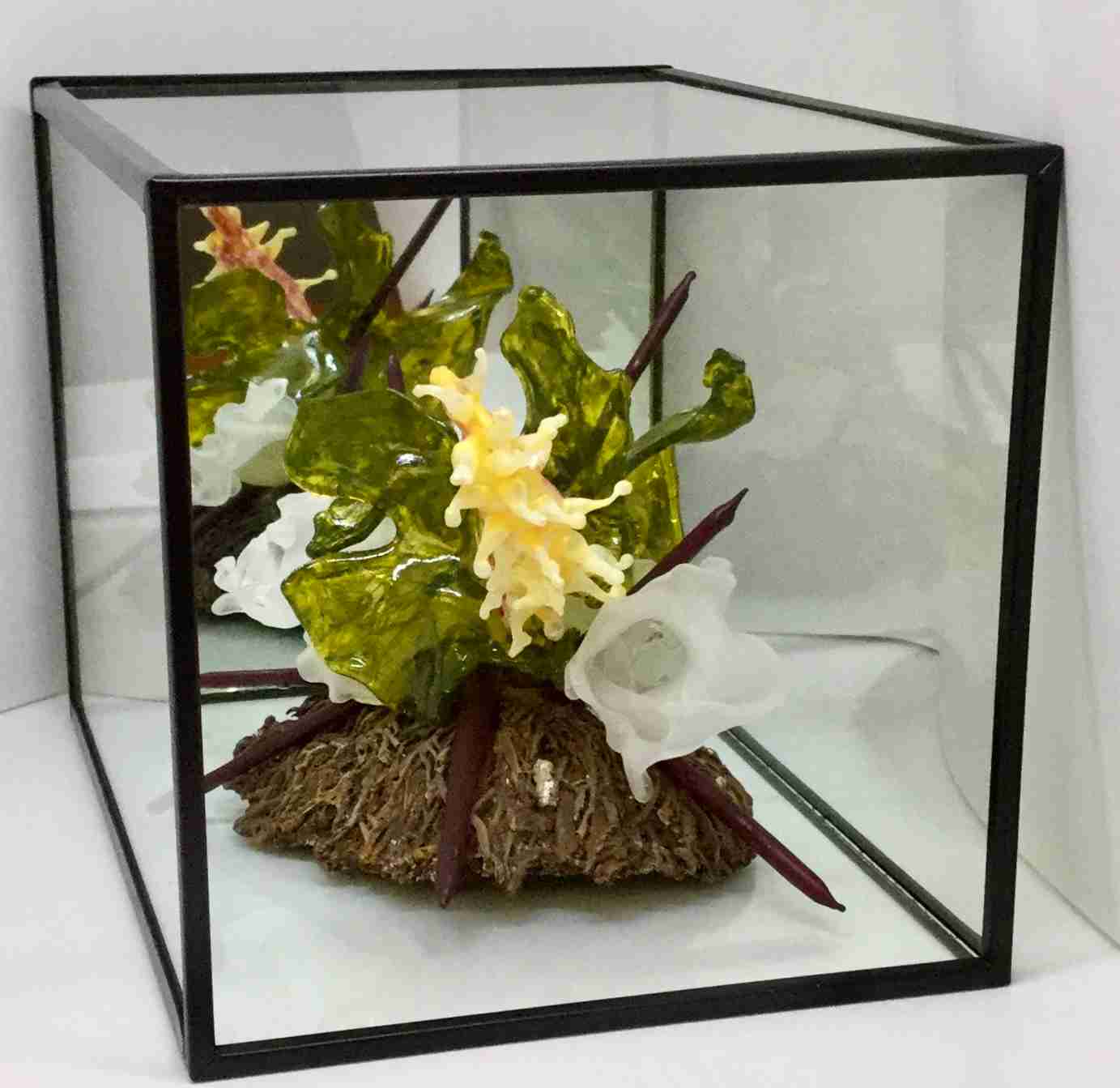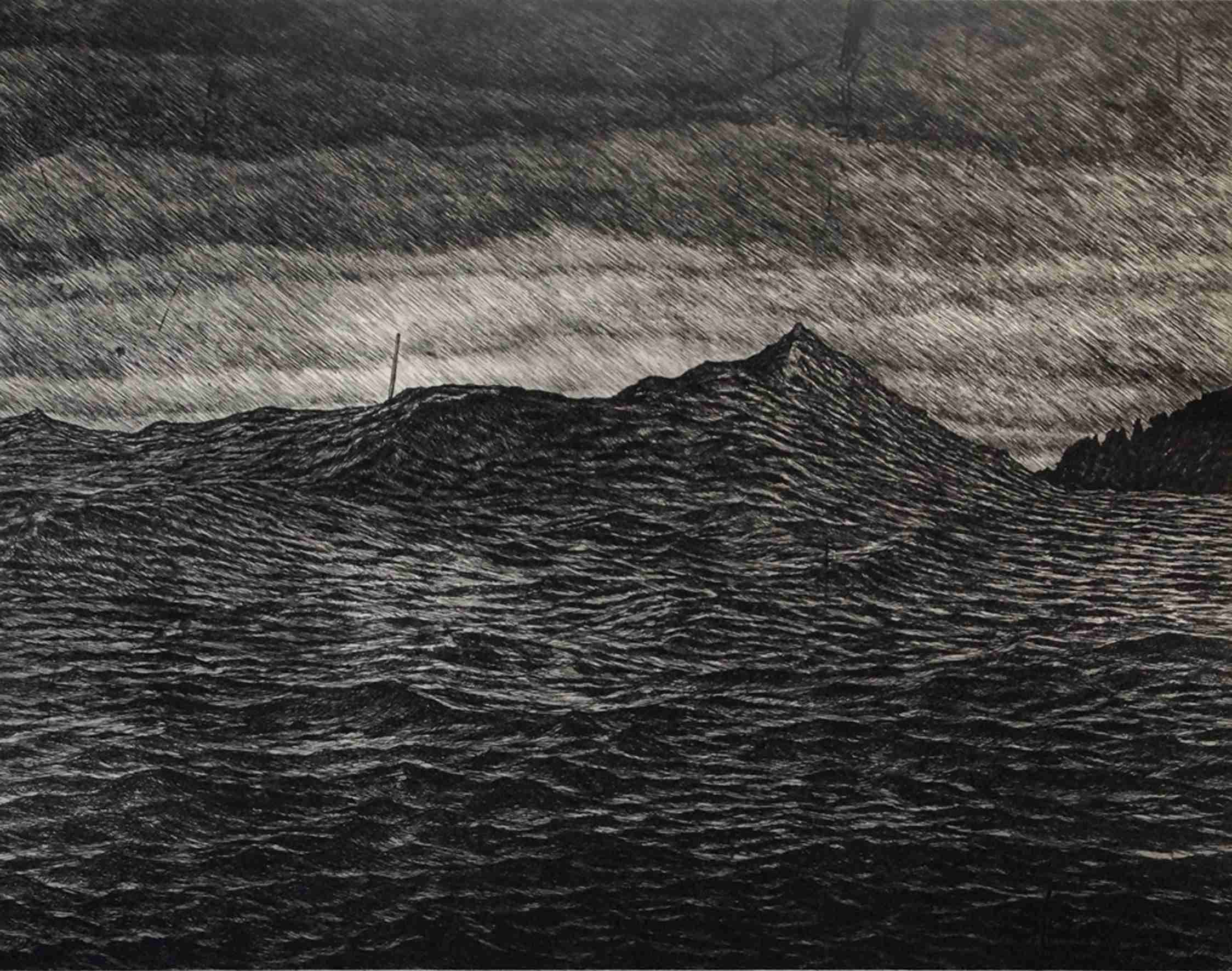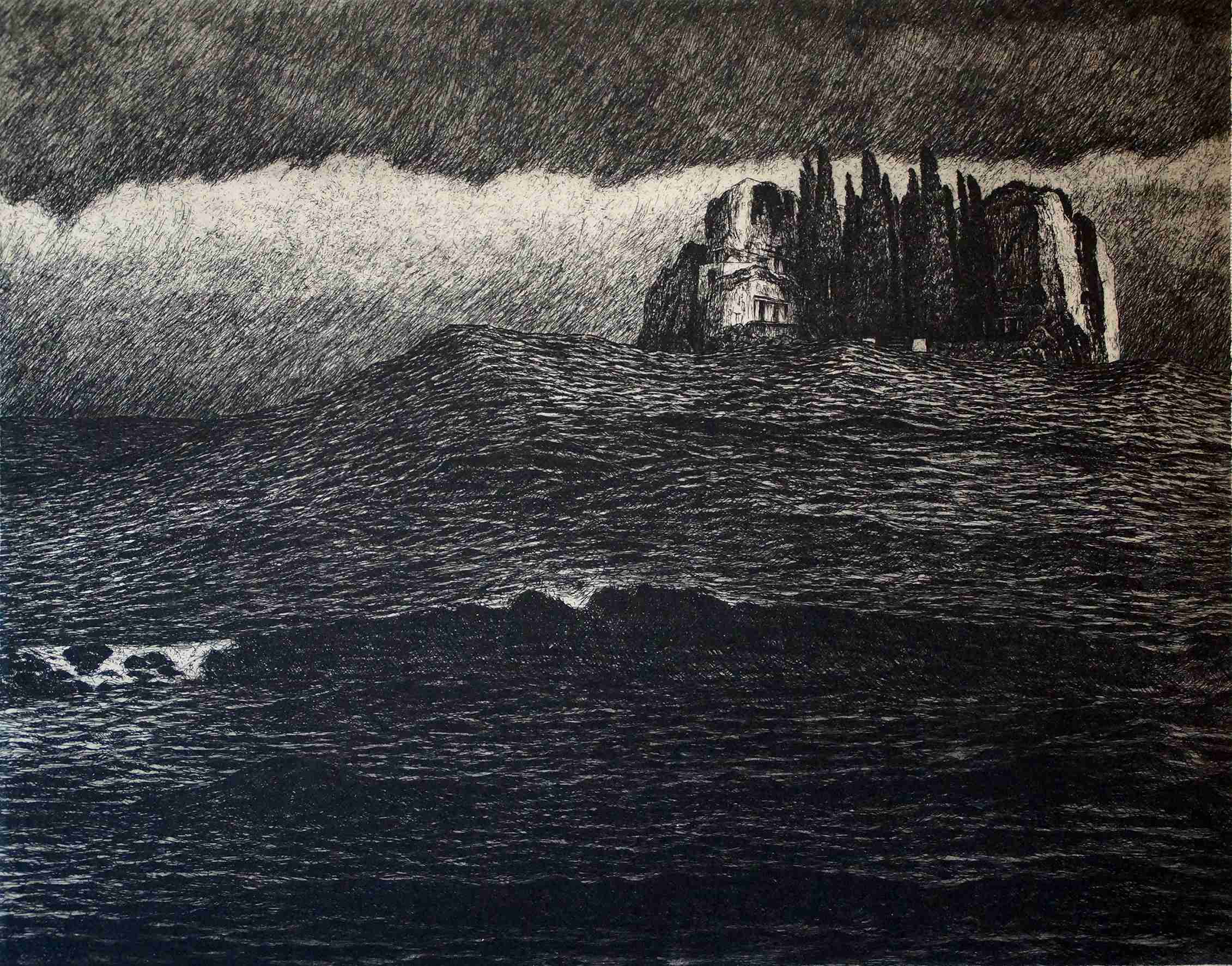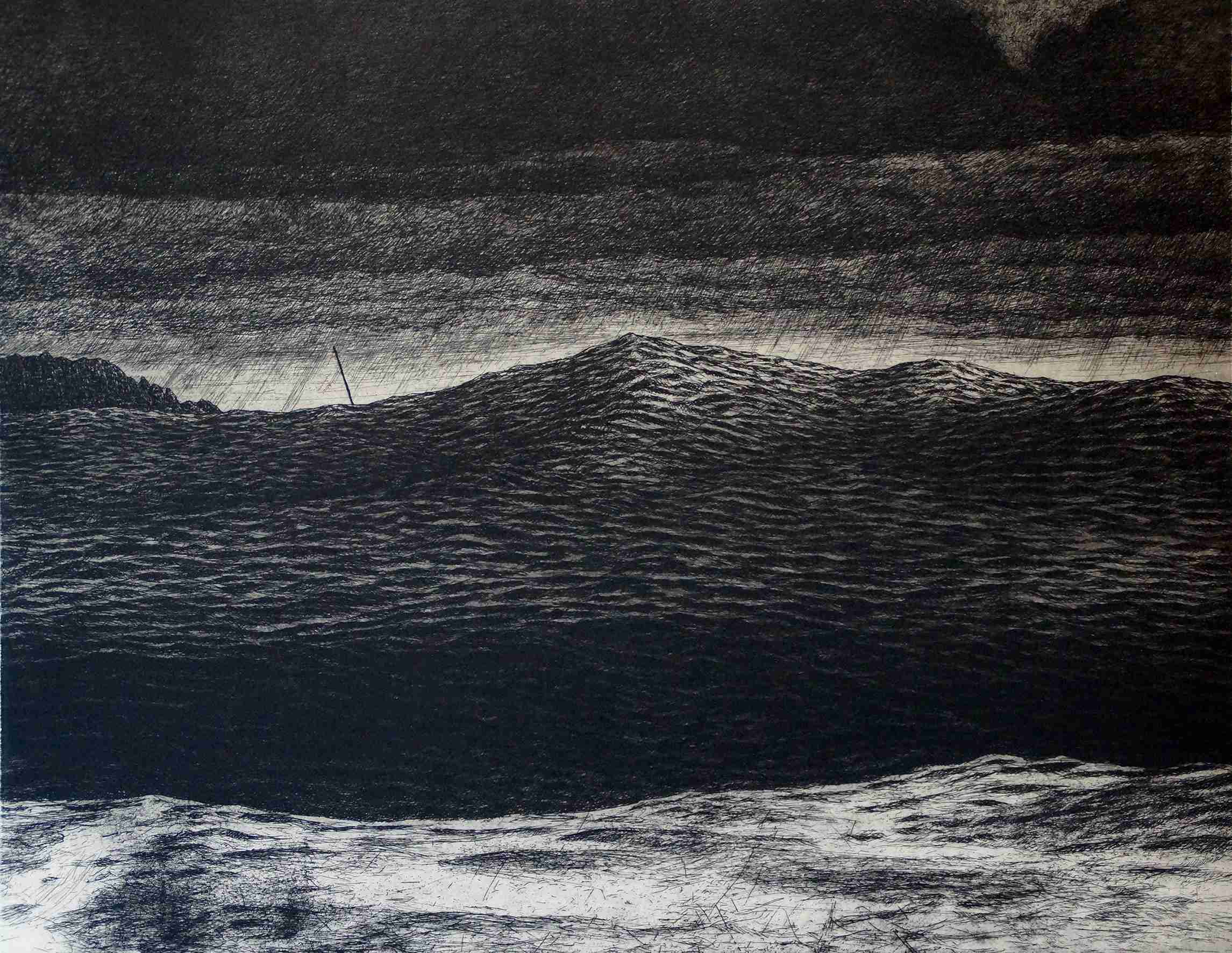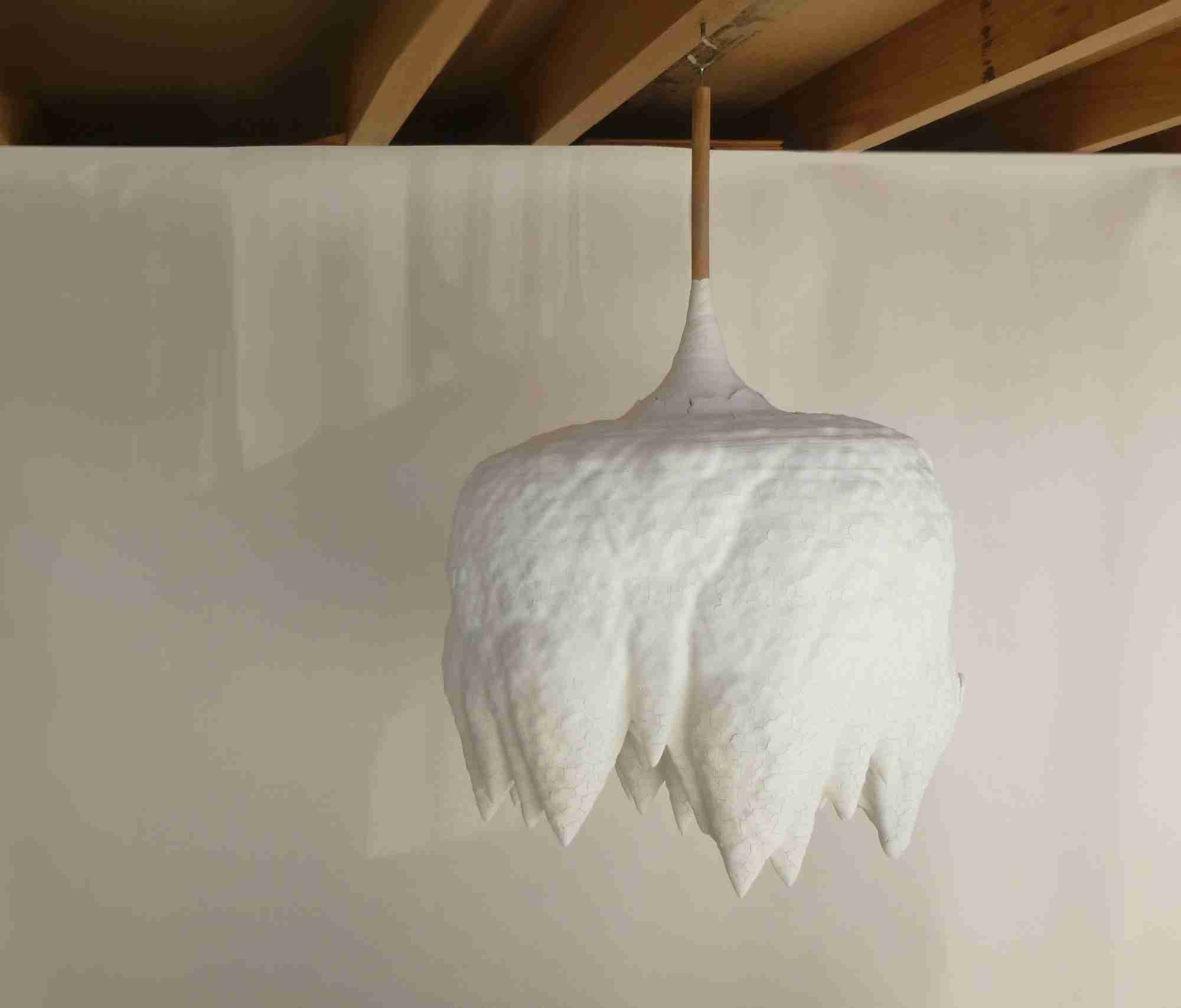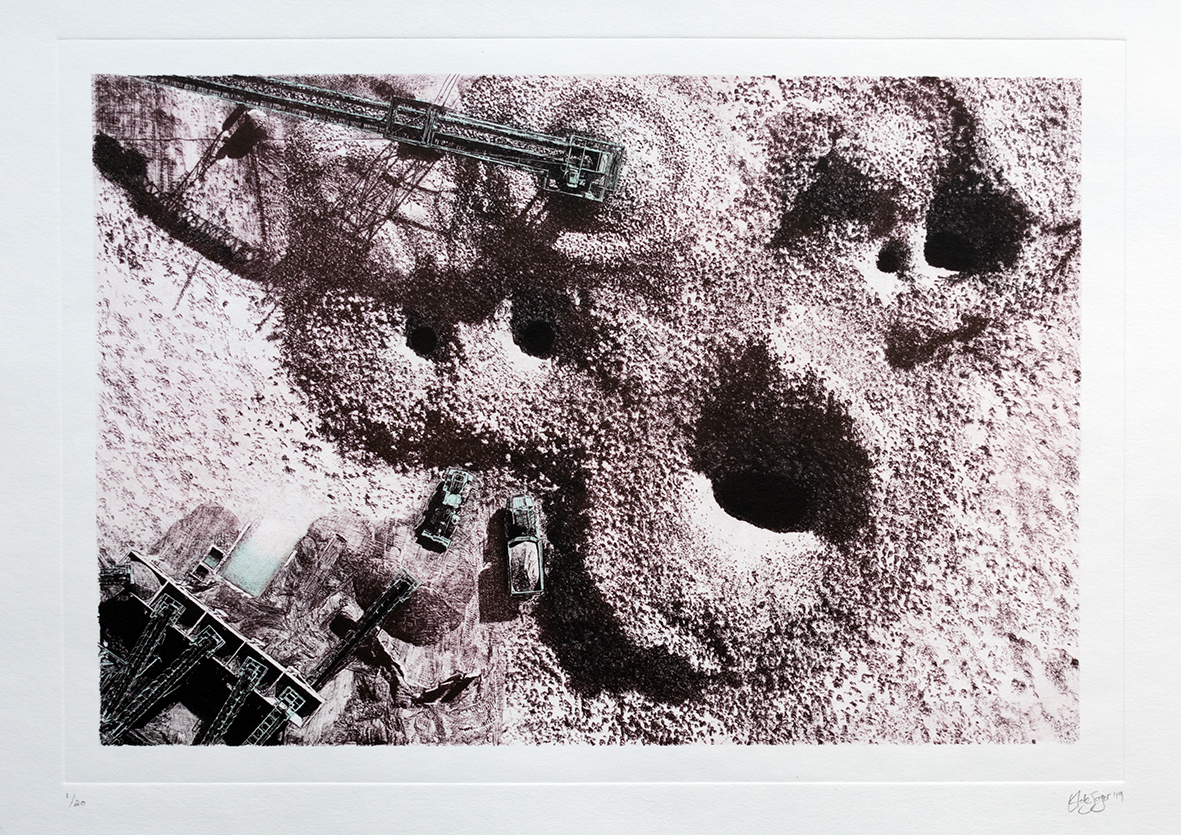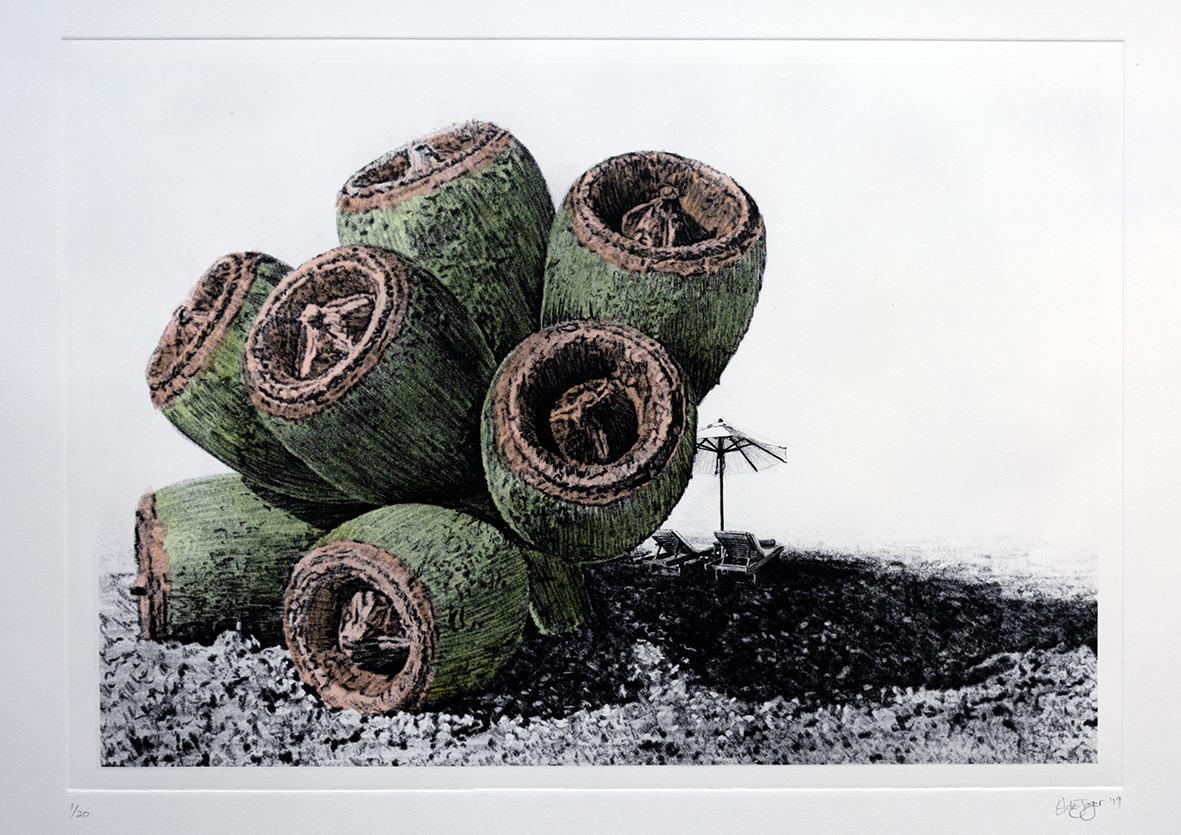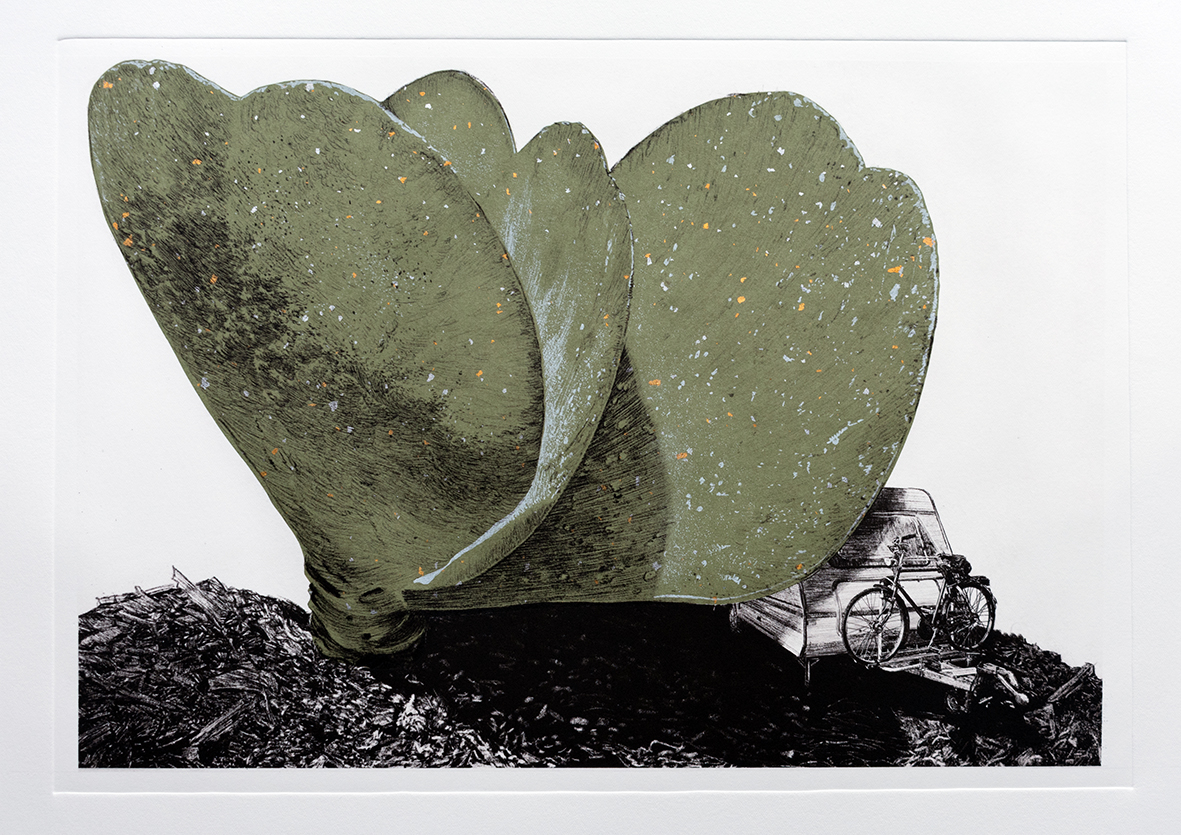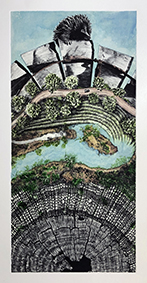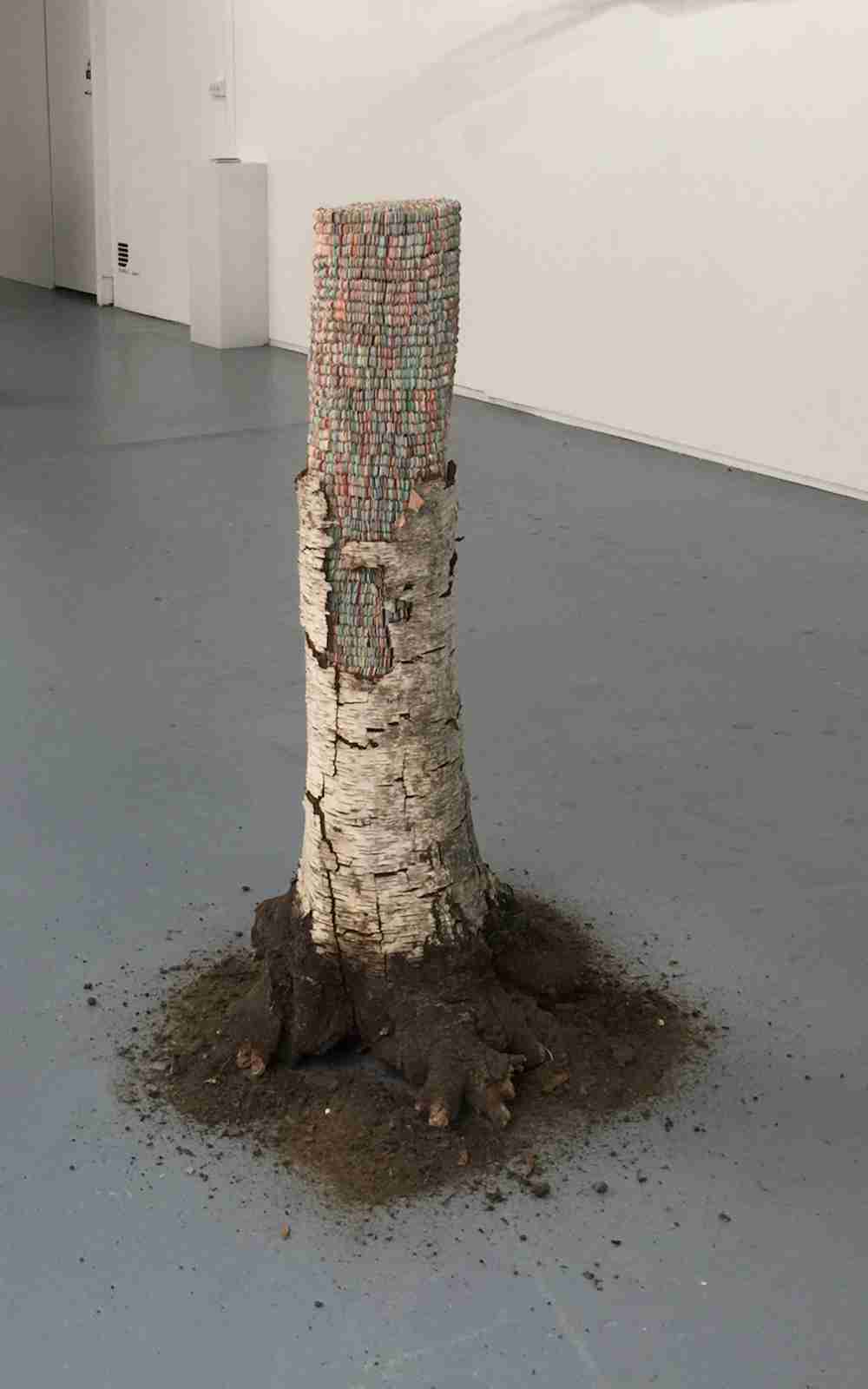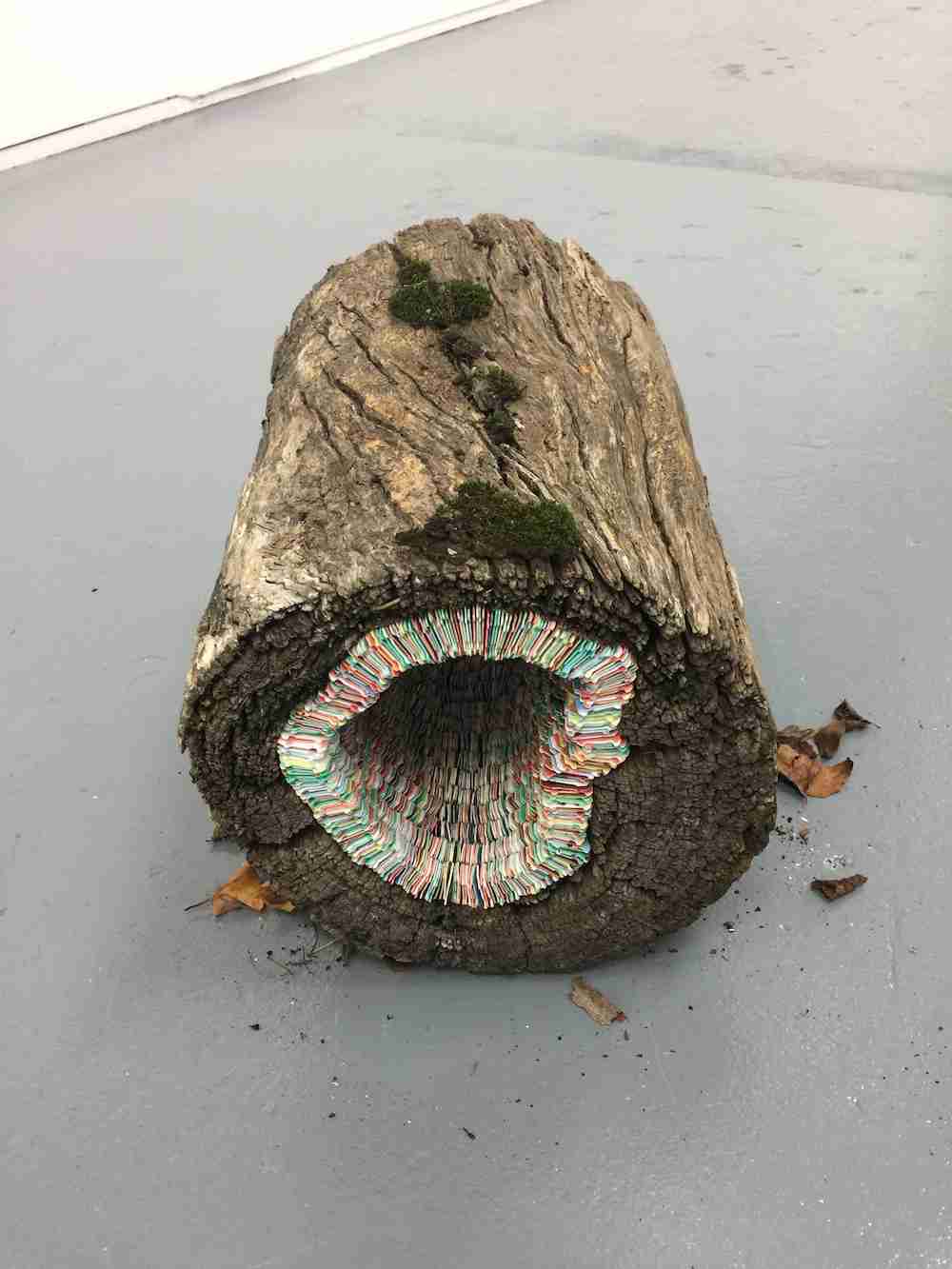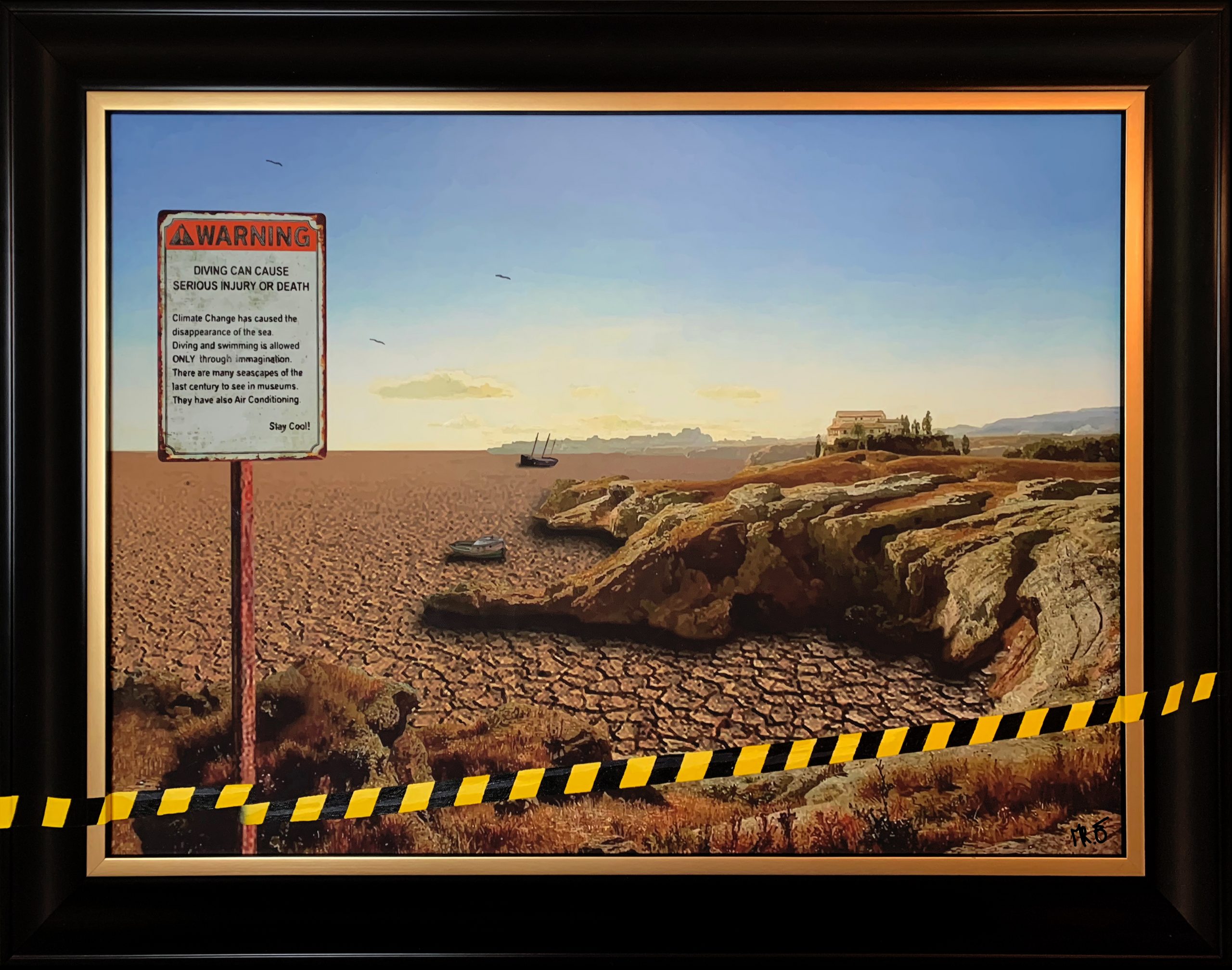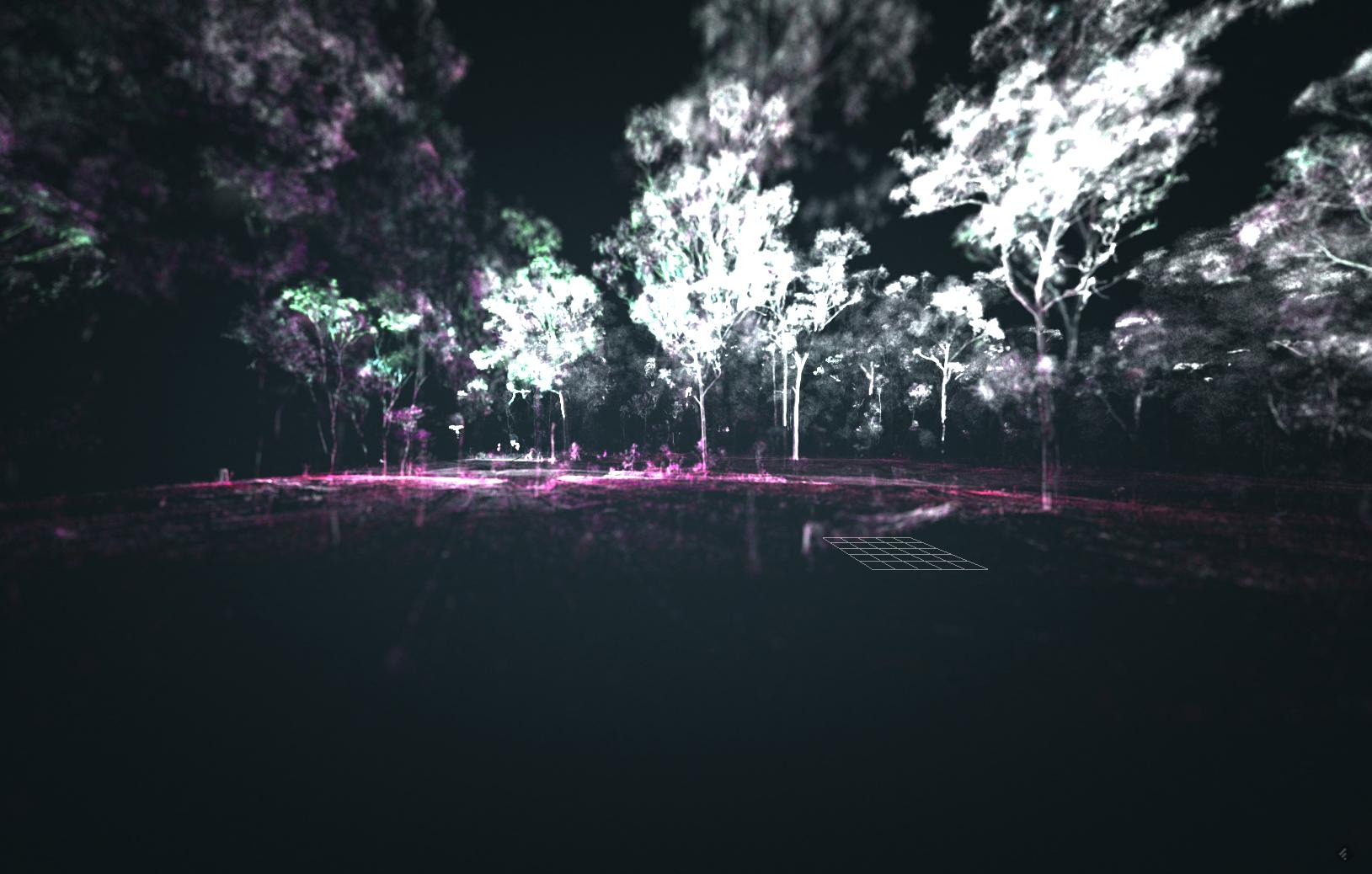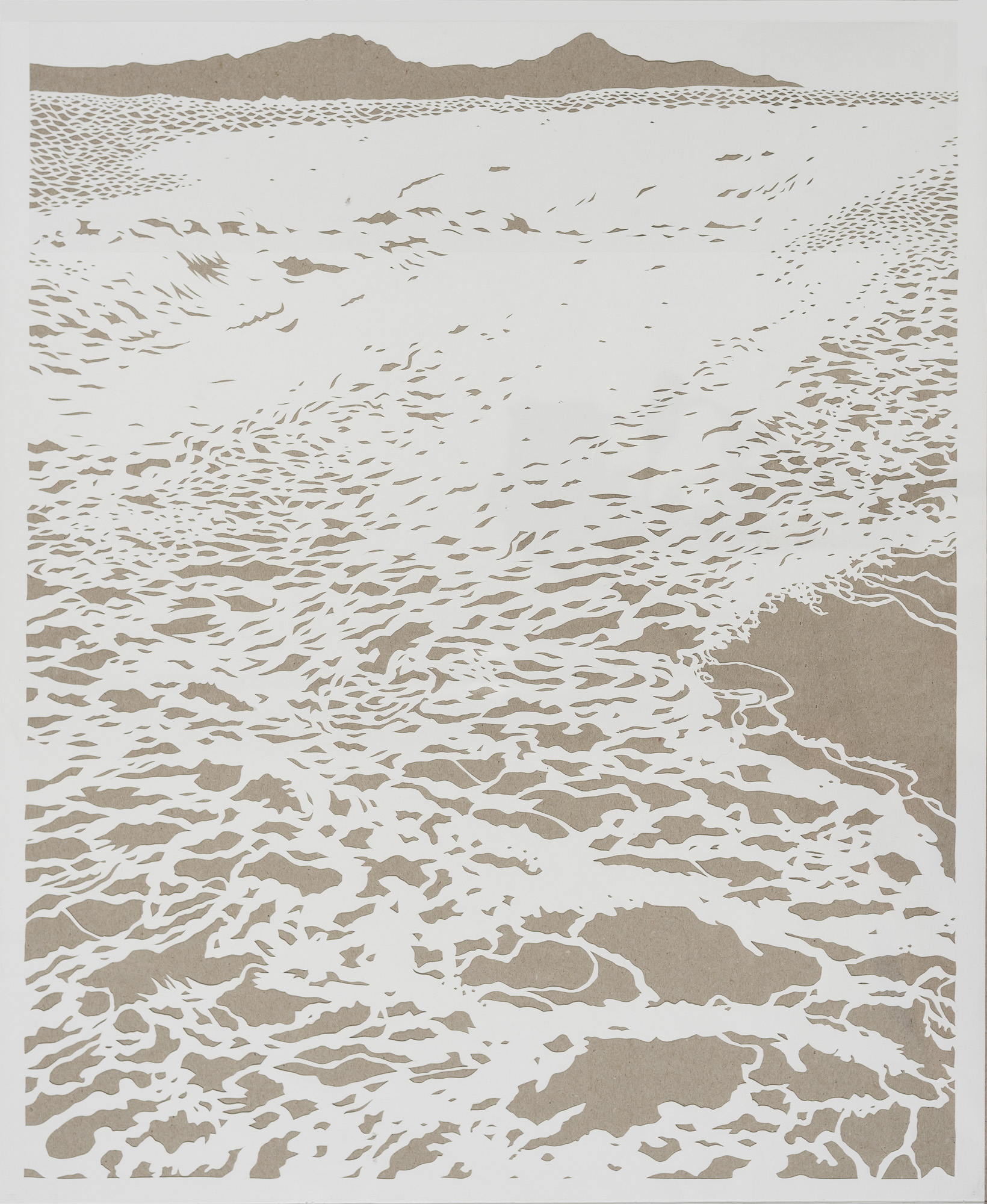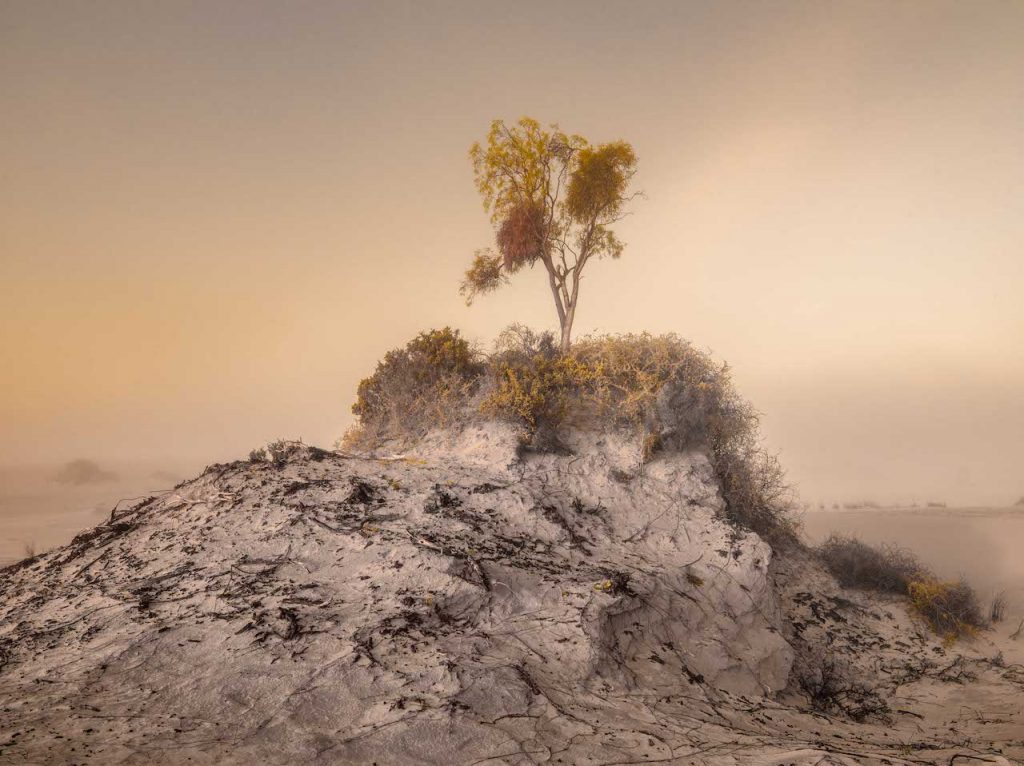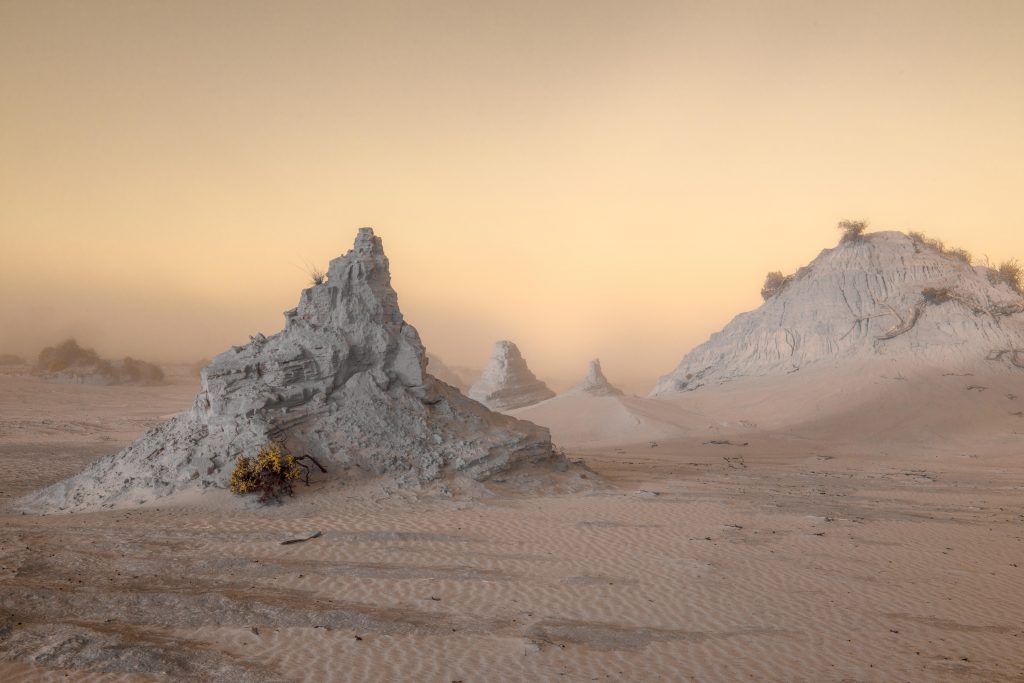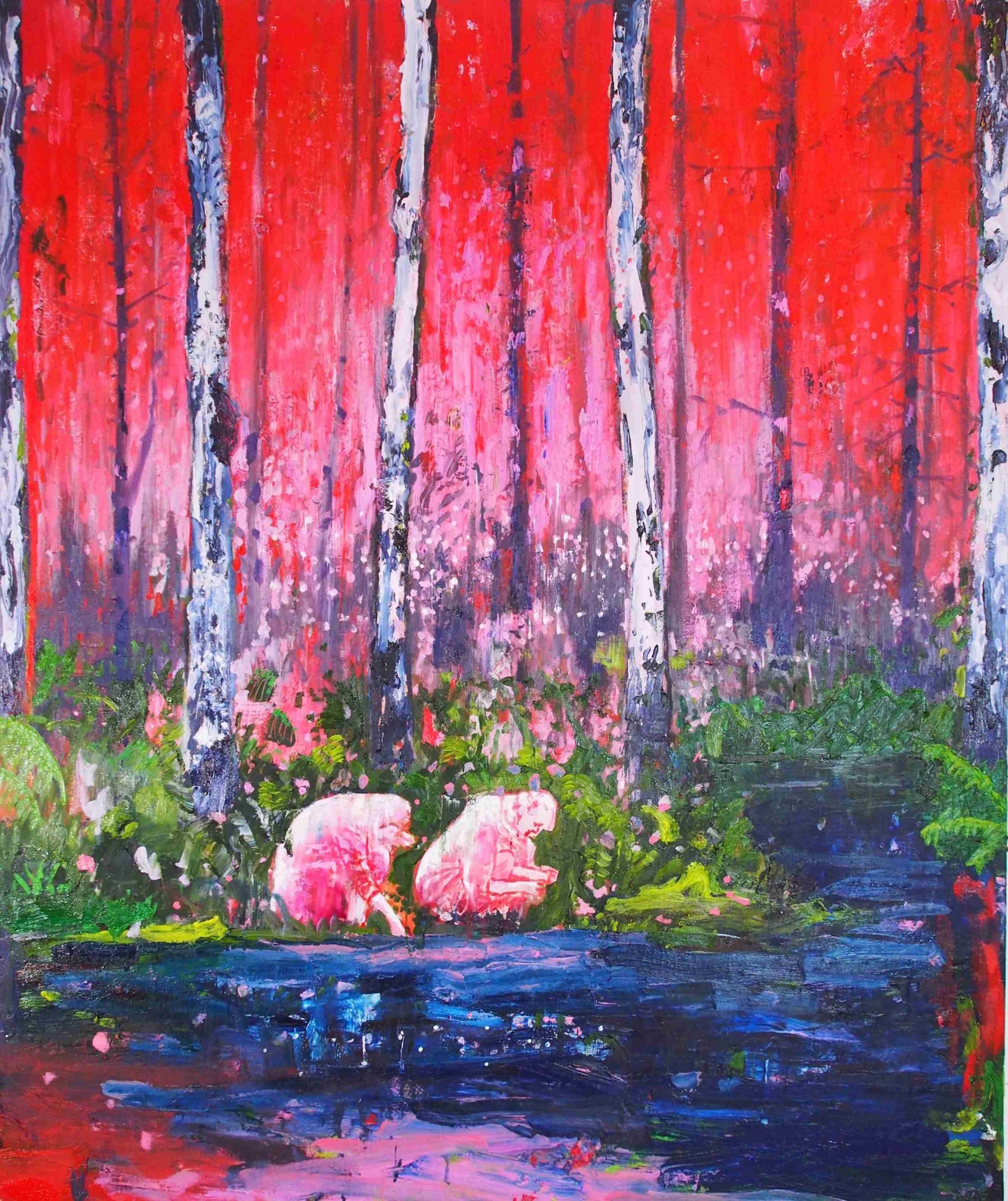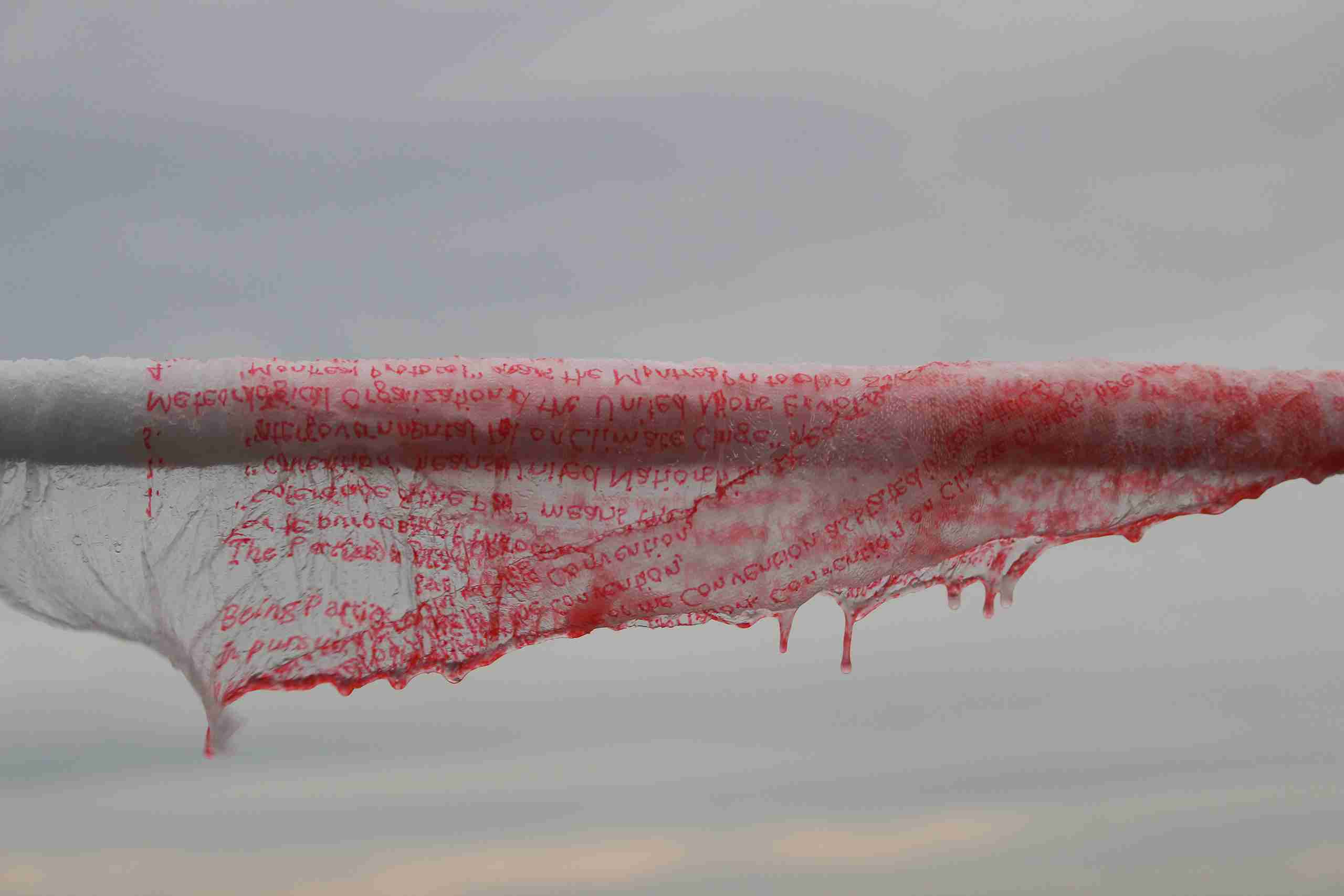The whirlwind of data and opinion surrounding climate change can be overwhelming; how do we form something meaningful and informative out of all of the figures, news, opinions and anxiety surrounding this topic?
Art connects us to the problem in a felt way, it encourages engagement, deep thinking, problem-solving and questioning.
The title of this exhibition (1.5 Degrees) comes from the challenge of the global community to limit global warming to 1.5 degrees (above pre-industrial levels). It is about the science of climate change, communicated in diverse and intriguing ways.
17 Artist from across Australia explore our relationship to the planet, through explorations of the juncture between science and art, and the very human response to the looming threat of climate change.
CURATOR NOTES | Autumn Tansey – Guest Curator (ABOUT) | ABOUT ART AVISO
Skunk Control Event and tickets
Medium: Charcoal frottageon Hosho paper, Gold leaf
Dimensions: 2x(1.6mx48cm) 1x (1mx1.3m)
Medium: Synthetic Polymer Paint on Linen
Dimensions: 120x120cm
Medium: Acrylic on wood panel
Dimensions: 20 x 25 cm
Medium: acrylic on wood panel
Dimensions: 20 x 25 cm
Medium: Acrylic on wood panel
Dimensions: 20 x 25 cm
Medium: Acrylic on wood panel
Dimensions: 20 x 25 cm
Medium: Acrylic on wood panel
Dimensions: 20 x 25 cm
Medium: Acrylic on wood panel
Dimensions: 20x25
Medium: Acrylic & Oil on Old Wooden Drawer
Dimensions: H – 350mm W – 280mm D – 130mm
Medium: Acrylic & Oil on Old Wooden Drawer
Dimensions: H – 350mm W – 280mm D – 130mm
Medium: Mixed Medium with handmade paper and found rope
Dimensions: 36cmx34cm
Medium: Mixed Medium with handmade paper and found rope
Dimensions: 60cmx45cm
Medium: Mixed Medium with handmade paper and found rope
Dimensions: 150cmx57cm
Medium: Sculpture - Flame-worked glass, glass paints, found marine plant, found glass display box, assembled
Dimensions: 17cm H x 15cmW x 27cmL
Medium: Etching
Dimensions: 76 x 56cm
Medium: Etching
Dimensions: 76 x 56cm
Medium: Etching
Dimensions: 76 x 56cm
Medium: wooden spoon, acrylic paint, paint tin
Dimensions:
Medium: Oil on Canvas
Dimensions: 152 x 121 cm
Medium: Photopolymer Etching. A la poupée & hand coloured.
Dimensions: 65cm (w) x 55cm (h) (Framed)
Medium: Photopolymer Etching. Hand coloured.
Dimensions: 65cm (w) x 55cm (h) (Framed)
Medium: Photopolymer Etching. Chine-collé.
Dimensions: 65cm (w) x 55cm (h) (Framed)
Medium: Photopolymer Etching. Chine-collé & hand coloured.
Dimensions: 50cm (w) x 78cm (h) (Framed)
Medium: wood, plastics
Dimensions: 40x40x100cm
Medium: wood, plastics
Dimensions: 40x40x40cm
Medium: Mixed Media
Dimensions: 85cm X 66.5cm
Medium: 4k Video, Lidar scans, Bioacoustic recordings. TERN Data.
Dimensions: NA
Medium: Papercut Acid Free 120 gsm Fabriano White paper
Dimensions: W620 x H745 mm Framed
Medium: Digital print on Chromaluxe metal
Dimensions: 90cm x 60cm
Medium: Digital print on Chromaluxe metal
Dimensions: 90cm x 60cm
Medium: oil and wax on linen
Dimensions: 152 x 176 cm
Medium: red ink on water soluble fabric, garment rack
Dimensions: NA
The intrinsic value of a tree alters each time its shape and meaning alters, and depending on who is viewing it. As a living organism and part of a forest, it holds a greater value than it holds on its own. However the monetary value of a single tree is what most humans seem to be interested in.
A charcoal frottage represents the commercial value of a tree. Gold leaf signifies the areas that fit into an economically viable shape which can be cut, transported, and sold most economically. What is leftover outside this area is discarded as waste.
What’s left in the bush is a forest of stumps, soon to be burnt in the name of ‘regeneration’. These would be homes to ecosystems that support life, including our own. These thoughts conjure images of burnt blackened homes on our TV screens after what are becoming all too familiar bushfires.
Artist Statement:
PRICE:$1600
ART AVISO PROFILE
Medium: Charcoal frottageon Hosho paper, Gold leaf
Dimensions: 2x(1.6mx48cm) 1x (1mx1.3m)
The word trophic derives from the Greek τροφή (trophē) referring to food or nourishment.
George Carlin:
“The planet will be here for a long, long, LONG time after we’re gone, and it will heal itself, it will cleanse itself, ’cause that’s what it does. It’s a self-correcting system. The air and the water will recover, the earth will be renewed. And if it’s true that plastic is not degradable, well, the planet will simply incorporate plastic into a new paradigm: the earth plus plastic. The earth doesn’t share our prejudice toward plastic. Plastic came out of the earth. The earth probably sees plastic as just another one of its children. Could be the only reason the earth allowed us to be spawned from it in the first place. It wanted plastic for itself. Didn’t know how to make it. Needed us. Could be the answer to our age-old egocentric philosophical question, “Why are we here?”
Plastic… asshole.”
Artist Statement:
Ecological pyramids begin with producers on the bottom (such as plants) and proceed through the various trophic levels (such as herbivores that eat plants, then carnivores that eat flesh, then omnivores that eat both plants and flesh, and so on). The highest level is the top of the food chain.
My work draws from images of both real and imaginary places within the body and the landscape, to examine the future of our environment, relationships between micro and macro worlds and the language, forms and networks that exist within our biosphere and beyond.
By making reference to biological processes within nature and the body, altering them and creating fictitious scenarios and relationships between them, I aim to examine and create dialog regarding the boundaries of what is internal/external and what is natural /artificial within the environment and the point where science meets science fiction.
PRICE: POA
ART AVISO PROFILE
Medium: Synthetic Polymer Paint on Linen
Dimensions: 120x120cm
Thirty years ago, while living in Canada, I hiked and sketched some of the spectacular glaciers there, humbled by a landscape that seemingly payed no heed to human presence. Last year I researched how those glaciers were being affected by a warming world. I sought out photographers and scientists whose recent images were taken in the same season, from the same viewpoint as my early sketches.
These works continue my response to visits to glaciers on four continents, and contrasts new works based on my 1980s originals, with compelling photographs of the glaciers’ decline viewed via the use of a QR code exhibited with each work.
As the glaciers withdraw in lockstep around the world, their glacial pace has become a sprint.
Here six acrylic abstractions based on lived experience are paired with digital images of someone else’s memory, creating visual elements seen and unseen.
In the liminal spaces between solid and liquid, memory and present, between action and inaction, I encourage contemplation on water; the impact a 1.5° rise will have on its global, increasingly fragile, interconnected cycle, our total dependence upon it, and the swiftly evaporating time we all have to make a difference.
Digital Image Photographer:
Alan Majchrowicz: Floe Lake and Hanging Glacier, BC Canada 2016
Artist Statement: Catherine Fitz-Gerald is a South Australian artist recognized for her luminous oils and light filled abstracts. Over the years Catherine’s works have focused on many themes and social issues including the slow food movement, food miles, mental health and climate change.
Always inspired by nature and light her current work explores water, the interfaces where dry land becomes submerged by water and life changes, the alteration of state as glaciers melt from solid to liquid, natural water systems and how humanity’s use affects the water cycle.Catherine’s works often begin with memory, a direct and specific moment in time. Using slices of light and simplified forms her abstractions create images particular to time and place that are still able to be ‘anywhere’ and encourage a link to the viewer’s own memories.Catherine has participated in many group exhibitions as artist and curator and held multiple solo exhibitions to great success. Her works can be found in private collections in Europe, Asia, USA and throughout Australia.
PRICE:$320
Link to Digital image
ART AVISO PROFILE
Medium: Acrylic on wood panel
Dimensions: 20 x 25 cm
FULL TITLE: Transposition 30 – Wedgemount Glacier, BC 1988
Photographer: Anton Rogozin: Wedgemount Glacier, BC Canada 2018
Thirty years ago, while living in Canada, I hiked and sketched some of the spectacular glaciers there, humbled by a landscape that seemingly payed no heed to human presence. Last year I researched how those glaciers were being affected by a warming world. I sought out photographers and scientists whose recent images were taken in the same season, from the same viewpoint as my early sketches.
These works continue my response to visits to glaciers on four continents, and contrasts new works based on my 1980s originals, with compelling photographs of the glaciers’ decline viewed via the use of a QR code exhibited with each work.
As the glaciers withdraw in lockstep around the world, their glacial pace has become a sprint.
Here six acrylic abstractions based on lived experience are paired with digital images of someone else’s memory, creating visual elements seen and unseen.
In the liminal spaces between solid and liquid, memory and present, between action and inaction, I encourage contemplation on water; the impact a 1.5° rise will have on its global, increasingly fragile, interconnected cycle, our total dependence upon it, and the swiftly evaporating time we all have to make a difference.
Artist Statement: Catherine Fitz-Gerald is a South Australian artist recognized for her luminous oils and light filled abstracts. Over the years Catherine’s works have focused on many themes and social issues including the slow food movement, food miles, mental health and climate change. Always inspired by nature and light her current work explores water, the interfaces where dry land becomes submerged by water and life changes, the alteration of state as glaciers melt from solid to liquid, natural water systems and how humanity’s use affects the water cycle.Catherine’s works often begin with memory, a direct and specific moment in time. Using slices of light and simplified forms her abstractions create images particular to time and place that are still able to be ‘anywhere’ and encourage a link to the viewer’s own memories.
Catherine has participated in many group exhibitions as artist and curator and held multiple solo exhibitions to great success. Her works can be found in private collections in Europe, Asia, USA and throughout Australia.
PRICE: $320
Link to Digital Image
ART AVISO PROFILE
Medium: acrylic on wood panel
Dimensions: 20 x 25 cm
FULL TITLE:Transposition 31 – Illecillewaet Glacier, Alberta 1988
Photographer: Justek 16: Illecillewaet Glacier Terminal, Alberta 2013
Thirty years ago, while living in Canada, I hiked and sketched some of the spectacular glaciers there, humbled by a landscape that seemingly payed no heed to human presence. Last year I researched how those glaciers were being affected by a warming world. I sought out photographers and scientists whose recent images were taken in the same season, from the same viewpoint as my early sketches. These works continue my response to visits to glaciers on four continents, and contrasts new works based on my 1980s originals, with compelling photographs of the glaciers’ decline viewed via the use of a QR code exhibited with each work.
As the glaciers withdraw in lockstep around the world, their glacial pace has become a sprint. Here six acrylic abstractions based on lived experience are paired with digital images of someone else’s memory, creating visual elements seen and unseen.
In the liminal spaces between solid and liquid, memory and present, between action and inaction, I encourage contemplation on water; the impact a 1.5° rise will have on its global, increasingly fragile, interconnected cycle, our total dependence upon it, and the swiftly evaporating time we all have to make a difference.
Artist Statement:
Catherine Fitz-Gerald is a South Australian artist recognized for her luminous oils and light filled abstracts. Over the years Catherine’s works have focused on many themes and social issues including the slow food movement, food miles, mental health and climate change.
Always inspired by nature and light her current work explores water, the interfaces where dry land becomes submerged by water and life changes, the alteration of state as glaciers melt from solid to liquid, natural water systems and how humanity’s use affects the water cycle. Catherine’s works often begin with memory, a direct and specific moment in time. Using slices of light and simplified forms her abstractions create images particular to time and place that are still able to be ‘anywhere’ and encourage a link to the viewer’s own memories. Catherine has participated in many group exhibitions as artist and curator and held multiple solo exhibitions to great success. Her works can be found in private collections in Europe, Asia, USA and throughout Australia.
PRICE: $320
Link to Digital Image
ART AVISO PROFILE
Medium: Acrylic on wood panel
Dimensions: 20 x 25 cm
FULL TITLE:Transposition 32 – Franz Josef Glacier, New Zealand 1997
Photographer: David Killeck: The frozen tears of New Zealand’s melting glaciers DW Media 2018
Thirty years ago, while living in Canada, I hiked and sketched some of the spectacular glaciers there, humbled by a landscape that seemingly payed no heed to human presence. Last year I researched how those glaciers were being affected by a warming world. I sought out photographers and scientists whose recent images were taken in the same season, from the same viewpoint as my early sketches.
These works continue my response to visits to glaciers on four continents, and contrasts new works based on my 1980s originals, with compelling photographs of the glaciers’ decline viewed via the use of a QR code exhibited with each work.
As the glaciers withdraw in lockstep around the world, their glacial pace has become a sprint.
Here six acrylic abstractions based on lived experience are paired with digital images of someone else’s memory, creating visual elements seen and unseen.
In the liminal spaces between solid and liquid, memory and present, between action and inaction, I encourage contemplation on water; the impact a 1.5° rise will have on its global, increasingly fragile, interconnected cycle, our total dependence upon it, and the swiftly evaporating time we all have to make a difference.
Artist Statement:
Catherine Fitz-Gerald is a South Australian artist recognized for her luminous oils and light filled abstracts. Over the years Catherine’s works have focused on many themes and social issues including the slow food movement, food miles, mental health and climate change.
Always inspired by nature and light her current work explores water, the interfaces where dry land becomes submerged by water and life changes, the alteration of state as glaciers melt from solid to liquid, natural water systems and how humanity’s use affects the water cycle. Catherine’s works often begin with memory, a direct and specific moment in time. Using slices of light and simplified forms her abstractions create images particular to time and place that are still able to be ‘anywhere’ and encourage a link to the viewer’s own memories.Catherine has participated in many group exhibitions as artist and curator and held multiple solo exhibitions to great success. Her works can be found in private collections in Europe, Asia, USA and throughout Australia.
PRICE: $320
Link to Digital Image
ART AVISO PROFILE
Medium: Acrylic on wood panel
Dimensions: 20 x 25 cm
FULL TITLE:Transposition 33 – Galambra Glacier, Moncenisio Mountains Italy, Circa 1954
Photographer: M Tron: 2009 Researchgate.net/publication/281179322
Thirty years ago, while living in Canada, I hiked and sketched some of the spectacular glaciers there, humbled by a landscape that seemingly payed no heed to human presence. Last year I researched how those glaciers were being affected by a warming world. I sought out photographers and scientists whose recent images were taken in the same season, from the same viewpoint as my early sketches.
These works continue my response to visits to glaciers on four continents, and contrasts new works based on my 1980s originals, with compelling photographs of the glaciers’ decline viewed via the use of a QR code exhibited with each work.
As the glaciers withdraw in lockstep around the world, their glacial pace has become a sprint.
Here six acrylic abstractions based on lived experience are paired with digital images of someone else’s memory, creating visual elements seen and unseen.
In the liminal spaces between solid and liquid, memory and present, between action and inaction, I encourage contemplation on water; the impact a 1.5° rise will have on its global, increasingly fragile, interconnected cycle, our total dependence upon it, and the swiftly evaporating time we all have to make a difference.
Artist Statement:
Catherine Fitz-Gerald is a South Australian artist recognized for her luminous oils and light filled abstracts. Over the years Catherine’s works have focused on many themes and social issues including the slow food movement, food miles, mental health and climate change.
Always inspired by nature and light her current work explores water, the interfaces where dry land becomes submerged by water and life changes, the alteration of state as glaciers melt from solid to liquid, natural water systems and how humanity’s use affects the water cycle.Catherine’s works often begin with memory, a direct and specific moment in time. Using slices of light and simplified forms her abstractions create images particular to time and place that are still able to be ‘anywhere’ and encourage a link to the viewer’s own memories.Catherine has participated in many group exhibitions as artist and curator and held multiple solo exhibitions to great success. Her works can be found in private collections in Europe, Asia, USA and throughout Australia.
PRICE: $320
Link to Digital Image
ART AVISO PROFILE
Medium: Acrylic on wood panel
Dimensions: 20 x 25 cm
FULL TITLE: Transposition 29 – Helm Lake, BC 1988
Photographer: Tom Dempsey: Black Tusk and Helm Lake, BC Canada 2015
Thirty years ago, while living in Canada, I hiked and sketched some of the spectacular glaciers there, humbled by a landscape that seemingly payed no heed to human presence. Last year I researched how those glaciers were being affected by a warming world. I sought out photographers and scientists whose recent images were taken in the same season, from the same viewpoint as my early sketches.
These works continue my response to visits to glaciers on four continents, and contrasts new works based on my 1980s originals, with compelling photographs of the glaciers’ decline viewed via the use of a QR code exhibited with each work.
As the glaciers withdraw in lockstep around the world, their glacial pace has become a sprint.
Here six acrylic abstractions based on lived experience are paired with digital images of someone else’s memory, creating visual elements seen and unseen.
In the liminal spaces between solid and liquid, memory and present, between action and inaction, I encourage contemplation on water; the impact a 1.5° rise will have on its global, increasingly fragile, interconnected cycle, our total dependence upon it, and the swiftly evaporating time we all have to make a difference.
Artist Statement: Catherine Fitz-Gerald is a South Australian artist recognized for her luminous oils and light filled abstracts. Over the years Catherine’s works have focused on many themes and social issues including the slow food movement, food miles, mental health and climate change.
Always inspired by nature and light her current work explores water, the interfaces where dry land becomes submerged by water and life changes, the alteration of state as glaciers melt from solid to liquid, natural water systems and how humanity’s use affects the water cycle.
Catherine’s works often begin with memory, a direct and specific moment in time. Using slices of light and simplified forms her abstractions create images particular to time and place that are still able to be ‘anywhere’ and encourage a link to the viewer’s own memories.
Catherine has participated in many group exhibitions as artist and curator and held multiple solo exhibitions to great success. Her works can be found in private collections in Europe, Asia, USA and throughout Australia.
PRICE: $320
Link to Digital Image
ART AVISO PROFILE
Medium: Acrylic on wood panel
Dimensions: 20x25
These 2 works express the extremes of weather variables we currently face in Australia.
Water is scarce and our poor land is crumbling under our feet. On those unbearably hot days when the temperature peaks well above 40 I wonder if the birds will just start falling out of the sky. I can’t believe it when a change blows through and they are all still out there. Lack of rain lead me to “The Very Long Drought”.
“The Really Big Flood” was inspired by Queensland floods and the devastating amount of water that fell & will fall…..unless of course all that region becomes a desert…..great for fish….not so great for humans – but I guess that’s the whole point of Climate Change – the earth is crying upon us.
Artist Statement:
Because humans can be pretty banal and that is actually, in reality, overwhelmingly fascinating. Our unedited failings and moments of simplicity and tenderness are not so funny, but might be. Random ideas. Painted on reclaimed remnants of neighbourhood renovated kitchens and discarded cupboards and drawers.
PRICE: $325
ART AVISO
Medium: Acrylic & Oil on Old Wooden Drawer
Dimensions: H – 350mm W – 280mm D – 130mm
These 2 works express the extremes of weather variables we currently face in Australia.
Water is scarce and our poor land is crumbling under our feet. On those unbearably hot days when the temperature peaks well above 40 I wonder if the birds will just start falling out of the sky. I can’t believe it when a change blows through and they are all still out there. Lack of rain lead me to “The Very Long Drought”.
“The Really Big Flood” was inspired by Queensland floods and the devastating amount of water that fell & will fall…..unless of course all that region becomes a desert…..great for fish….not so great for humans – but I guess that’s the whole point of Climate Change – the earth is crying upon us.
Artist Statement:
Because humans can be pretty banal and that is actually, in reality, overwhelmingly fascinating. Our unedited failings and moments of simplicity and tenderness are not so funny, but might be. Random ideas. Painted on reclaimed remnants of neighbourhood renovated kitchens and discarded cupboards and drawers.
PRICE: $325
ART AVISO
Medium: Acrylic & Oil on Old Wooden Drawer
Dimensions: H – 350mm W – 280mm D – 130mm
What the Sea Leaves and Fiery Embers are works created as a direct response to being affected by floods and bushfires in Australia and seeing first-hand the results of glacier melt during my artist residency in Iceland.
Both sets of works use paper pulp embedded with burnt leaves and ash which were washed up by the tides in northern NSW following the bushfires in early November.
What the Sea Leaves has been created using paper pulp from cotton sheets donated to flood affected families in Townsville which has been overlaid into remnants of a discarded fishing net sourced from my local Pottsville Beach.
Fiery Embers is made from pulped torn up papers which were damaged during the flooding of my Murwillumbah art studio in March 2017. This pulp was manipulated into sculptural installations using remnants from the same fishing net and includes crushed papers dyed with ink stitched onto a cloth strip torn from a hi-vis shirt and orange pulp made from this cloth. These reference the emergency service workers who are called to help during climate change disasters. This shirt was also sourced from donations to the Salvation Army in Townsville following the flood in early 2019.
These materials carry the energy of places affected by climate change. They are entangled into sections of the washed up fishing net which has been mended and re-mended. It is a metaphor for our planetary interconnectedness and speaks of the hopeful efforts to address and mend this climatic emergency.
Artist Statement:
Paper forms the basis of my art, it is both my material and my passion. Much of my work features collages and folded artist books using my own handmade banana paper. In 2017 my papermaking art studio was flooded in the aftermath of Cyclone Debbie. This provided an opportunity to create work about climate change using flood affected papers.
Primarily I make paper with banana fibre from locally grown banana trees. I was one of three artists bequeathed the equipment and techniques to make banana paper from a retiring Japanese papermaker. He taught us the eastern method of making paper which is a one step process of drying paper on the mould without pressing it.
While banana paper is my foundational medium, I also use cotton and fabric from recycled clothing and bed linen, especially to embed meaning into an art project. Choosing the type of fibre becomes part of the papers story. When making my most recent work about climate change I created paper from cotton workmen’s shirts and bed sheets donated to the families who were affected by floods in north Queensland. To this paper pulp I added soot and burnt leaf inclusions which were washed onto the beach after the rolling succession of Australian bushfires.
Stitched paper collages connect me to my matrilineal lineage, but are expressed in the rough and imperfect, with loose threads often tangled and left hanging. These collages embed my thoughts to a time and place and have become my default artistic practice.
PRICE: $250
ART AVISO PROFILE
Medium: Mixed Medium with handmade paper and found rope
Dimensions: 36cmx34cm
What the Sea Leaves and Fiery Embers are works created as a direct response to being affected by floods and bushfires in Australia and seeing first-hand the results of glacier melt during my artist residency in Iceland.
Both sets of works use paper pulp embedded with burnt leaves and ash which were washed up by the tides in northern NSW following the bushfires in early November.
What the Sea Leaves has been created using paper pulp from cotton sheets donated to flood affected families in Townsville which has been overlaid into remnants of a discarded fishing net sourced from my local Pottsville Beach.
Fiery Embers is made from pulped torn up papers which were damaged during the flooding of my Murwillumbah art studio in March 2017. This pulp was manipulated into sculptural installations using remnants from the same fishing net and includes crushed papers dyed with ink stitched onto a cloth strip torn from a hi-vis shirt and orange pulp made from this cloth. These reference the emergency service workers who are called to help during climate change disasters. This shirt was also sourced from donations to the Salvation Army in Townsville following the flood in early 2019.
These materials carry the energy of places affected by climate change. They are entangled into sections of the washed up fishing net which has been mended and re-mended. It is a metaphor for our planetary interconnectedness and speaks of the hopeful efforts to address and mend this climatic emergency.
Artist Statement:
Paper forms the basis of my art, it is both my material and my passion. Much of my work features collages and folded artist books using my own handmade banana paper. In 2017 my papermaking art studio was flooded in the aftermath of Cyclone Debbie. This provided an opportunity to create work about climate change using flood affected papers.
Primarily I make paper with banana fibre from locally grown banana trees. I was one of three artists bequeathed the equipment and techniques to make banana paper from a retiring Japanese papermaker. He taught us the eastern method of making paper which is a one step process of drying paper on the mould without pressing it.
While banana paper is my foundational medium, I also use cotton and fabric from recycled clothing and bed linen, especially to embed meaning into an art project. Choosing the type of fibre becomes part of the papers story. When making my most recent work about climate change I created paper from cotton workmen’s shirts and bed sheets donated to the families who were affected by floods in north Queensland. To this paper pulp I added soot and burnt leaf inclusions which were washed onto the beach after the rolling succession of Australian bushfires.
Stitched paper collages connect me to my matrilineal lineage, but are expressed in the rough and imperfect, with loose threads often tangled and left hanging. These collages embed my thoughts to a time and place and have become my default artistic practice.
PRICE: $350
ART AVISO PROFILE
Medium: Mixed Medium with handmade paper and found rope
Dimensions: 60cmx45cm
What the Sea Leaves and Fiery Embers are works created as a direct response to being affected by floods and bushfires in Australia and seeing first-hand the results of glacier melt during my artist residency in Iceland.
Both sets of works use paper pulp embedded with burnt leaves and ash which were washed up by the tides in northern NSW following the bushfires in early November.
What the Sea Leaves has been created using paper pulp from cotton sheets donated to flood affected families in Townsville which has been overlaid into remnants of a discarded fishing net sourced from my local Pottsville Beach.
Fiery Embers is made from pulped torn up papers which were damaged during the flooding of my Murwillumbah art studio in March 2017. This pulp was manipulated into sculptural installations using remnants from the same fishing net and includes crushed papers dyed with ink stitched onto a cloth strip torn from a hi-vis shirt and orange pulp made from this cloth. These reference the emergency service workers who are called to help during climate change disasters. This shirt was also sourced from donations to the Salvation Army in Townsville following the flood in early 2019.
These materials carry the energy of places affected by climate change. They are entangled into sections of the washed up fishing net which has been mended and re-mended. It is a metaphor for our planetary interconnectedness and speaks of the hopeful efforts to address and mend this climatic emergency.
Artist Statement:
Paper forms the basis of my art, it is both my material and my passion. Much of my work features collages and folded artist books using my own handmade banana paper. In 2017 my papermaking art studio was flooded in the aftermath of Cyclone Debbie. This provided an opportunity to create work about climate change using flood affected papers.
Primarily I make paper with banana fibre from locally grown banana trees. I was one of three artists bequeathed the equipment and techniques to make banana paper from a retiring Japanese papermaker. He taught us the eastern method of making paper which is a one step process of drying paper on the mould without pressing it.
While banana paper is my foundational medium, I also use cotton and fabric from recycled clothing and bed linen, especially to embed meaning into an art project. Choosing the type of fibre becomes part of the papers story. When making my most recent work about climate change I created paper from cotton workmen’s shirts and bed sheets donated to the families who were affected by floods in north Queensland. To this paper pulp I added soot and burnt leaf inclusions which were washed onto the beach after the rolling succession of Australian bushfires.
Stitched paper collages connect me to my matrilineal lineage, but are expressed in the rough and imperfect, with loose threads often tangled and left hanging. These collages embed my thoughts to a time and place and have become my default artistic practice.
PRICE: $330
ART AVISO PROFILE
Medium: Mixed Medium with handmade paper and found rope
Dimensions: 150cmx57cm
Local marine ecosystems face multidimensional threats from increasing acidification and warming of our oceans, encouraging invasive species to flourish and resulting in profound implications for the economic and social systems that depend upon them. The surface waters off the east coast of Tasmania have warmed by approximately 2°C over the past 60 years. This is two to three times the global rate. It can be the smaller, less obvious creatures and plants that have a major impact on degradation of our local marine worlds and are usually only brought to general public notice when they affect the economies of agriculture or fishing. Tasmania’s Giant Kelp forests have been bleached and then diminished by 95% in past decades due to higher sea temps and has seen them listed by the Australian Government as an endangered marine community. The tropical Long-Spined Sea Urchin feeds on marine algae, depriving other species of food and habitat and breeds more successfully in warming waters. We are on the verge of a population explosion that will see this invader cause lifeless ‘barrens’ in the biodiverse reef habitats across large areas of Tasmania’s east coast. The poisonous and voracious introduced predator the North Pacific Sea Star’s breeding rate is also controlled by sea temperature. The disruption of marine ecosystems in the Australian region due to global warming is likely to be greatest in our temperate waters, with the greatest warming off south-east Australia in the Tasman Sea; this area is a global ‘hotspot’.
Artist Statement:
Based in Launceston Tasmania, I am a chiefly self-taught glass artist and sculptor who utilises forms drawn from nature to comment upon contemporary themes. I am inspired by the vigour and fecundity of the diverse and extraordinary botanical forms to be found in the marine and terrestrial environments of my island home and delight in creating delicate works that celebrate the smaller things. I love the potential of glass to exploit transparency, colour and light and to be simultaneously fragile and robust. Soda lime and borosilicate glass rods and tubes are manipulated in the flame of my torch and then I add additional colour or texture to the glass surface through sandblasting, painting or pencil before assembling sculptural components. I often capture the botanical sculptures under glass like the scientific specimen displays of the 19th century, sometimes creating quasi scientific names for imagined forms. I was a finalist in the Bay of Fires Art Award and the sculpture award Artentwine in 2018 and a finalist in the Tom Bass Prize 2020.
PRICE: $390
ART AVISO PROFILE
Medium: Sculpture - Flame-worked glass, glass paints, found marine plant, found glass display box, assembled
Dimensions: 17cm H x 15cmW x 27cmL
The wave of change series is an emotionally charged and evocative suite of recent etchings by Joel Wolter that presents to us forces of nature contrasted against, at times, small traces and remnants of humanity, as represented by a solitary mast traversing an unrelenting sea, or a haunting island set against rising seas and threatening skies. Initially these images evoke an elusive and mysterious feeling and aesthetic, yet on further inspection they become familiar messages to us that resonate with the intimate changes and challenges we might face in our everyday lives. The waves in these images also rumble with the broader and more consequential changes that will affect the environment and our lives in the not too distant future, such as climate change.
Some of these etchings have been created on recycled sheets of copper plate, showcasing the old marks and wounds in the metal, and using the same techniques that have been utilised by artists for centuries. Using such historically and graphically rich techniques is partly what draws Wolter to the medium of etching. The duteous tasks and processes, the drawing and atmospheric capabilities, and the sometimes unforgiving and mysterious nature of etching has also kept Joel building up his images on the copper plate, sometimes through many etching grounds and proofs, for some 20 years.
Artist Statement:
Joel Wolter is a visual artist residing on the Victorian Surf Coast. Born in Geelong in 1978, Joel holds a Bachelor of Fine Art from the Victorian College of the Arts and has many years of experience as a professional printmaker and as an art educator. Joel is widely exhibited across Australia and his artworks have been selected and represented in many significant exhibitions including the Geelong Acquisitive Print Awards, the Rick Amor Print Prize, the Waterhouse Natural History Art Prize, Print Traditions – Sources of Australian Printmaking and the Fremantle Print Awards to mention a few. Joel was recently awarded the 2019 Peebles Print Prize at Queenscliff Gallery and Workshop which grants him a residency at the Scuola Internazionale di Grafica in Venice, Italy. Joel’s artwork is represented in public collections including the Geelong Gallery, the State Library of Victoria, the Parliament of Australia, and the Victorian College of the Arts.
PRICE: $750 (Framed) $500 (Unframed)
ART AVISO PROFILE
Medium: Etching
Dimensions: 76 x 56cm
The wave of change series is an emotionally charged and evocative suite of recent etchings by Joel Wolter that presents to us forces of nature contrasted against, at times, small traces and remnants of humanity, as represented by a solitary mast traversing an unrelenting sea, or a haunting island set against rising seas and threatening skies. Initially these images evoke an elusive and mysterious feeling and aesthetic, yet on further inspection they become familiar messages to us that resonate with the intimate changes and challenges we might face in our everyday lives. The waves in these images also rumble with the broader and more consequential changes that will affect the environment and our lives in the not too distant future, such as climate change.
Some of these etchings have been created on recycled sheets of copper plate, showcasing the old marks and wounds in the metal, and using the same techniques that have been utilised by artists for centuries. Using such historically and graphically rich techniques is partly what draws Wolter to the medium of etching. The duteous tasks and processes, the drawing and atmospheric capabilities, and the sometimes unforgiving and mysterious nature of etching has also kept Joel building up his images on the copper plate, sometimes through many etching grounds and proofs, for some 20 years.
Artist Statement:
Joel Wolter is a visual artist residing on the Victorian Surf Coast. Born in Geelong in 1978, Joel holds a Bachelor of Fine Art from the Victorian College of the Arts and has many years of experience as a professional printmaker and as an art educator. Joel is widely exhibited across Australia and his artworks have been selected and represented in many significant exhibitions including the Geelong Acquisitive Print Awards, the Rick Amor Print Prize, the Waterhouse Natural History Art Prize, Print Traditions – Sources of Australian Printmaking and the Fremantle Print Awards to mention a few. Joel was recently awarded the 2019 Peebles Print Prize at Queenscliff Gallery and Workshop which grants him a residency at the Scuola Internazionale di Grafica in Venice, Italy. Joel’s artwork is represented in public collections including the Geelong Gallery, the State Library of Victoria, the Parliament of Australia, and the Victorian College of the Arts.
PRICE: $750 (Framed) $500 (Unframed)
ART AVISO PROFILE
Medium: Etching
Dimensions: 76 x 56cm
The wave of change series is an emotionally charged and evocative suite of recent etchings by Joel Wolter that presents to us forces of nature contrasted against, at times, small traces and remnants of humanity, as represented by a solitary mast traversing an unrelenting sea, or a haunting island set against rising seas and threatening skies. Initially these images evoke an elusive and mysterious feeling and aesthetic, yet on further inspection they become familiar messages to us that resonate with the intimate changes and challenges we might face in our everyday lives. The waves in these images also rumble with the broader and more consequential changes that will affect the environment and our lives in the not too distant future, such as climate change.
Some of these etchings have been created on recycled sheets of copper plate, showcasing the old marks and wounds in the metal, and using the same techniques that have been utilised by artists for centuries. Using such historically and graphically rich techniques is partly what draws Wolter to the medium of etching. The duteous tasks and processes, the drawing and atmospheric capabilities, and the sometimes unforgiving and mysterious nature of etching has also kept Joel building up his images on the copper plate, sometimes through many etching grounds and proofs, for some 20 years.
Artist Statement:
Joel Wolter is a visual artist residing on the Victorian Surf Coast. Born in Geelong in 1978, Joel holds a Bachelor of Fine Art from the Victorian College of the Arts and has many years of experience as a professional printmaker and as an art educator. Joel is widely exhibited across Australia and his artworks have been selected and represented in many significant exhibitions including the Geelong Acquisitive Print Awards, the Rick Amor Print Prize, the Waterhouse Natural History Art Prize, Print Traditions – Sources of Australian Printmaking and the Fremantle Print Awards to mention a few. Joel was recently awarded the 2019 Peebles Print Prize at Queenscliff Gallery and Workshop which grants him a residency at the Scuola Internazionale di Grafica in Venice, Italy. Joel’s artwork is represented in public collections including the Geelong Gallery, the State Library of Victoria, the Parliament of Australia, and the Victorian College of the Arts.
PRICE: $750 (Framed) $500 (Unframed)
ART AVISO PROFILE
Medium: Etching
Dimensions: 76 x 56cm
Every morning in 2018 I dipped a wooden spoon into a can of paint. Setting out on January the first I was sure of the process, the materials and the time frame.A spoon, a tin of paint, a daily ritual for one full year. Size was the great unknown.You would think that a little coat of paint wouldn’t be a thing of consequence? Similarly, 1.5 degrees isn’t a big thing is it? Each day in increasing astonishment I was witness to a swelling, cleaving, collapsing, geological, exponential, greedy, demanding growth. On one hand, the daily expansion of this work highlights the dangers of frightening, uncontrolled growth but as the year progressed there was joy. Joy in the sense of – ‘from little things big things grow’. There is hope if we work together. In unity there is strength. Change can be achieved with the smallest of daily actions.
Artist Statement:
I was born in Geelong and live in Melbourne, Australia. In the early 1980s I completed an Arts degree with a major in Philosophy. It wasn’t until my mid-thirties that I began doing art which has from the beginning included both oil painting and mixed media assemblage. Since 2014 I have mainly focussed on wooden sculpture and assemblage with occasional detours into conceptual territory. I was one of the founding members of 69 Smith St artist-run Gallery in Fitzroy in 1998. I currently volunteer at Yarra Sculpture Gallery. Over the last six years I have been a finalist and very occasional winner in various art prizes including The Woollahra Small Sculpture Prize, The Deakin University Contemporary Small Sculpture Prize, The Substation Contemporary Art prize, The incinerator Art Award and the Yering Sculpture Exhibition and Awards. As I said, sculpture has been my focus of late but I would not be surprised if I return to painting in the future.
PRICE: POA
ART AVISO PROFILE
Medium: wooden spoon, acrylic paint, paint tin
Dimensions:
Maralinga Landscape II – (Taranaki) is part of a new body of work: as of yet not completed or shown anywhere before, and in many ways a culmination of all the paintings I have done in this country for the last 2 decades.
Maralinga is what happens when absolute and total disregard of any consequences is shown to the land and its people, in many ways it is the apex of colonialism in its most arrogant form. It hasn’t borne real consequence for the perpetrators , as is the case with such acts of political and environmental violence.
I painted two versions of “Road to Maralinga” in 2007, two diptychs that only hinted at what Maralinga could be, as i had not yet had change to visit.
As fate would have it, “Road to Maralinga II” was included in a nationally touring show titled ” Black Mist Burnt Country” showcasing the work of several Australian Artists as well as the local indigenous community at Yulara, examining the legacy of Maralinga.
It was through ” Black mist burnt country” that I got the chance to visit Maralinga in September 2018, as well as visit the proposed nuclear waste dump sites at Barndioota and Kimba. My new body of work is based on the impressions of this trip.
This painting shows the landscape as you find it today – the site is too contaminated to camp overnight, a daunting vision of a possible future, accelerated.
Artist Statement:
Karen Standke , born 1973 in Munich Germany. Living and working in Melbourne, Australia.
Karen Standke has had a career in the arts spanning over 20 years, with exhibitions both nationally and internationally. Her work, whilst at first look an almost romantic depiction of the landscape, focuses on the areas that have suffered at times a devastating impact of human activity.The signs of these impacts can be subtle and almost beautiful in itself. Karen’s paintings are informed by thorough research into the changing face of the landscape and the impact of climate change, introduction of weeds and non native fauna and flora.There is an undeniable focus in Karen’s work on the beauty of this change and destruction – thus raising the question, how do we respond emotionally? how do we respond practically to these challenges?It is this juxtaposition that she is most interested in, informed by psychology, politics, religion and science.
PRICE: $6600
ART AVISO PROFILE
Medium: Oil on Canvas
Dimensions: 152 x 121 cm
I want to hide from the ever more dreadful news of how humans are impacting on the earth, but I also know that looking away at this moment in history would be infantile. In the name of progress we have done things we can never take back, but simultaneously our survival from this point onwards depends on us looking it straight in the eye.
Nature has become a branded, advertised and commodified ‘product’. Surely weirdness is going on when nature is being trademarked and patented! Human impact has never been presented as clearly as by the UN’s Intergovernmental Panel on Climate Change report.
During a residency in Mildura, I drove into the dry areas for research. I found plants that grow in areas that are, apparently, not compatible with life, yet these little legends thrive under the harshest elements and create havens for other life, like insects. These resilient plants need nearly nothing to survive but humans take so much that even that little bit might be gone soon, too. I imagined what the future might look like – when these tough legends of nature have survived climate change. These tough fauna and flora might become monuments to things our civilisation has ‘lost’, in similar ways we build statues to soldiers who have given their lives ‘for us’. In this way, maybe a modest knoll of grass can become an enormous icon, like the great Australian roadside attractions: the Big Banana in Coffs Harbour or the Big Merino in Goulburn.
Artist Statement:
I make drawings and transfer them to a metal-backed photopolymer etching plate. These plates are used for traditional intaglio print making. Each fine art print is made by hand, incorporating centuries old techniques, like chine-collé or a la poupée – with a huge variety or results. It is an ever evolving and endlessly creative way of making art.
It took me 25 years (while working as a graphic designer) to feel ready for making art full-time. I did not think it was as ‘useful’ as I could be in the world, meaning that I was too afraid to follow the thing that I yearned for the most. When our family suffered 3 losses of significant people in a 22 month period, I had a crisis of existence. In this makeshift moment in my life, I turned to art.
The original themes were (naturally) around loss and grief.
Next, I tackled the cultural pressures I grew up with. Conversations with my girlfriends about how women should act, what wives are expected to do or why we feel pressure to become mothers in a world where there are too many people already – these conversations fuelled a series of works where a small women is carrying a huge weight. These considered the mental health of women in our shared multi-culture.
Since May 2019 I’ve been visualising ideas around climate change, trying to process all the terrible news we are facing with regards to our impact on the earth.
PRICE: $780 (Framed) $480 (Unframed)
ART AVISO PROFILE
Medium: Photopolymer Etching. A la poupée & hand coloured.
Dimensions: 65cm (w) x 55cm (h) (Framed)
I want to hide from the ever more dreadful news of how humans are impacting on the earth, but I also know that looking away at this moment in history would be infantile. In the name of progress we have done things we can never take back, but simultaneously our survival from this point onwards depends on us looking it straight in the eye.
Nature has become a branded, advertised and commodified ‘product’. Surely weirdness is going on when nature is being trademarked and patented! Human impact has never been presented as clearly as by the UN’s Intergovernmental Panel on Climate Change report.
During a residency in Mildura, I drove into the dry areas for research. I found plants that grow in areas that are, apparently, not compatible with life, yet these little legends thrive under the harshest elements and create havens for other life, like insects. These resilient plants need nearly nothing to survive but humans take so much that even that little bit might be gone soon, too. I imagined what the future might look like – when these tough legends of nature have survived climate change. These tough fauna and flora might become monuments to things our civilisation has ‘lost’, in similar ways we build statues to soldiers who have given their lives ‘for us’. In this way, maybe a modest knoll of grass can become an enormous icon, like the great Australian roadside attractions: the Big Banana in Coffs Harbour or the Big Merino in Goulburn.
Artist Statement:
I make drawings and transfer them to a metal-backed photopolymer etching plate. These plates are used for traditional intaglio print making. Each fine art print is made by hand, incorporating centuries old techniques, like chine-collé or a la poupée – with a huge variety or results. It is an ever evolving and endlessly creative way of making art.
It took me 25 years (while working as a graphic designer) to feel ready for making art full-time. I did not think it was as ‘useful’ as I could be in the world, meaning that I was too afraid to follow the thing that I yearned for the most. When our family suffered 3 losses of significant people in a 22 month period, I had a crisis of existence. In this makeshift moment in my life, I turned to art.
The original themes were (naturally) around loss and grief.
Next, I tackled the cultural pressures I grew up with. Conversations with my girlfriends about how women should act, what wives are expected to do or why we feel pressure to become mothers in a world where there are too many people already – these conversations fuelled a series of works where a small women is carrying a huge weight. These considered the mental health of women in our shared multi-culture.
Since May 2019 I’ve been visualising ideas around climate change, trying to process all the terrible news we are facing with regards to our impact on the earth.
PRICE: $780 (Framed) $480 (Unframed)
ART AVISO PROFILE
Medium: Photopolymer Etching. Hand coloured.
Dimensions: 65cm (w) x 55cm (h) (Framed)
I want to hide from the ever more dreadful news of how humans are impacting on the earth, but I also know that looking away at this moment in history would be infantile. In the name of progress we have done things we can never take back, but simultaneously our survival from this point onwards depends on us looking it straight in the eye.
Nature has become a branded, advertised and commodified ‘product’. Surely weirdness is going on when nature is being trademarked and patented! Human impact has never been presented as clearly as by the UN’s Intergovernmental Panel on Climate Change report.
During a residency in Mildura, I drove into the dry areas for research. I found plants that grow in areas that are, apparently, not compatible with life, yet these little legends thrive under the harshest elements and create havens for other life, like insects. These resilient plants need nearly nothing to survive but humans take so much that even that little bit might be gone soon, too. I imagined what the future might look like – when these tough legends of nature have survived climate change. These tough fauna and flora might become monuments to things our civilisation has ‘lost’, in similar ways we build statues to soldiers who have given their lives ‘for us’. In this way, maybe a modest knoll of grass can become an enormous icon, like the great Australian roadside attractions: the Big Banana in Coffs Harbour or the Big Merino in Goulburn.
Artist Statement:
I make drawings and transfer them to a metal-backed photopolymer etching plate. These plates are used for traditional intaglio print making. Each fine art print is made by hand, incorporating centuries old techniques, like chine-collé or a la poupée – with a huge variety or results. It is an ever evolving and endlessly creative way of making art.
It took me 25 years (while working as a graphic designer) to feel ready for making art full-time. I did not think it was as ‘useful’ as I could be in the world, meaning that I was too afraid to follow the thing that I yearned for the most. When our family suffered 3 losses of significant people in a 22 month period, I had a crisis of existence. In this makeshift moment in my life, I turned to art.
The original themes were (naturally) around loss and grief.
Next, I tackled the cultural pressures I grew up with. Conversations with my girlfriends about how women should act, what wives are expected to do or why we feel pressure to become mothers in a world where there are too many people already – these conversations fuelled a series of works where a small women is carrying a huge weight. These considered the mental health of women in our shared multi-culture.
Since May 2019 I’ve been visualising ideas around climate change, trying to process all the terrible news we are facing with regards to our impact on the earth.
PRICE: $780 (Framed) $480 (unframed)
ART AVISO PROFILE
Medium: Photopolymer Etching. Chine-collé.
Dimensions: 65cm (w) x 55cm (h) (Framed)
I want to hide from the ever more dreadful news of how humans are impacting on the earth, but I also know that looking away at this moment in history would be infantile. In the name of progress we have done things we can never take back, but simultaneously our survival from this point onwards depends on us looking it straight in the eye.
Nature has become a branded, advertised and commodified ‘product’. Surely weirdness is going on when nature is being trademarked and patented! Human impact has never been presented as clearly as by the UN’s Intergovernmental Panel on Climate Change report.
During a residency in Mildura, I drove into the dry areas for research. I found plants that grow in areas that are, apparently, not compatible with life, yet these little legends thrive under the harshest elements and create havens for other life, like insects. These resilient plants need nearly nothing to survive but humans take so much that even that little bit might be gone soon, too. I imagined what the future might look like – when these tough legends of nature have survived climate change. These tough fauna and flora might become monuments to things our civilisation has ‘lost’, in similar ways we build statues to soldiers who have given their lives ‘for us’. In this way, maybe a modest knoll of grass can become an enormous icon, like the great Australian roadside attractions: the Big Banana in Coffs Harbour or the Big Merino in Goulburn.
Artist Statement:
I make drawings and transfer them to a metal-backed photopolymer etching plate. These plates are used for traditional intaglio print making. Each fine art print is made by hand, incorporating centuries old techniques, like chine-collé or a la poupée – with a huge variety or results. It is an ever evolving and endlessly creative way of making art.
It took me 25 years (while working as a graphic designer) to feel ready for making art full-time. I did not think it was as ‘useful’ as I could be in the world, meaning that I was too afraid to follow the thing that I yearned for the most. When our family suffered 3 losses of significant people in a 22 month period, I had a crisis of existence. In this makeshift moment in my life, I turned to art.
The original themes were (naturally) around loss and grief.
Next, I tackled the cultural pressures I grew up with. Conversations with my girlfriends about how women should act, what wives are expected to do or why we feel pressure to become mothers in a world where there are too many people already – these conversations fuelled a series of works where a small women is carrying a huge weight. These considered the mental health of women in our shared multi-culture.
Since May 2019 I’ve been visualising ideas around climate change, trying to process all the terrible news we are facing with regards to our impact on the earth.
PRICE: $980
ART AVISO PROFILE
Medium: Photopolymer Etching. Chine-collé & hand coloured.
Dimensions: 50cm (w) x 78cm (h) (Framed)
After seeing photographs of dead albatross’ their stomach’s full of shards of coloured plastic, I began to collect bread tags. All I thought of, at this stage, was that if I held onto these small plastic fragments they couldn’t be ingested by sea birds.
Initially, the work aimed to present fifty- two proposals, made over a year, for three dimensional works, reusing my collection of bread tags. The resulting series of photographs can be seen at Fitzroy library between February and April this year.
The project was extended to incorporate wooden logs, after the drought killed off a eucalyptus tree in my garden and after cutting it down and suspending it from my studio ceiling, I began to experiment with combining plastic in order to further explore ideas around environmental degradation. The ubiquitous use- by date acts a call to action, while the reference to our daily bread, calls to account the tragic irony wherein our own nourishment may be inadvertently contributing to the destruction of a species from starvation.
Artist Statement:
I am a multi disciplinary artist with a practice spanning thirty years. I studied at VCA in the eighties and completed an MA at RMIT in 2003. Since then I have painted, sewn, assembled, written and curated works that have been exhibited widely, in over fifty group shows and seventeen solo shows. After exhibiting with a commercial gallery for a short time in the ninetees I now show in artist run and alternative spaces. My most recent exhibition was shown at the Surf coast artspace in Anglesea in January this year, where I combined my Father’s landscape paintings from the eighties with my own sculptural objects that together track the changes in how we view the landscape.
Further to this project, I have become a registered drop off point for bread tags, which are recycled for use in 3 D printing- the details can be seen on the breadtags for wheelchairs facebook page.
PRICE: POA
ART AVISO PROFILE
Medium: wood, plastics
Dimensions: 40x40x100cm
After seeing photographs of dead albatross’ their stomach’s full of shards of coloured plastic, I began to collect bread tags. All I thought of, at this stage, was that if I held onto these small plastic fragments they couldn’t be ingested by sea birds.
Initially, the work aimed to present fifty- two proposals, made over a year, for three dimensional works, reusing my collection of bread tags. The resulting series of photographs can be seen at Fitzroy library between February and April this year.
The project was extended to incorporate wooden logs, after the drought killed off a eucalyptus tree in my garden and after cutting it down and suspending it from my studio ceiling, I began to experiment with combining plastic in order to further explore ideas around environmental degradation.The ubiquitous use- by date acts a call to action, while the reference to our daily bread, calls to account the tragic irony wherein our own nourishment may be inadvertently contributing to the destruction of a species from starvation.
Artist Statement:
I am a multi disciplinary artist with a practice spanning thirty years. I studied at VCA in the eighties and completed an MA at RMIT in 2003. Since then I have painted, sewn, assembled, written and curated works that have been exhibited widely, in over fifty group shows and seventeen solo shows. After exhibiting with a commercial gallery for a short time in the ninetees I now show in artist run and alternative spaces. My most recent exhibition was shown at the Surf coast artspace in Anglesea in January this year, where I combined my Father’s landscape paintings from the eighties with my own sculptural objects that together track the changes in how we view the landscape.
Further to this project, I have become a registered drop off point for bread tags, which are recycled for use in 3 D printing- the details can be seen on the breadtags for wheelchairs facebook page.
PRICE: POA
ART AVISO PROFILE
Medium: wood, plastics
Dimensions: 40x40x40cm
Warning signs are part of our life. Everyday we face them and we make decision based on them. We decide on which side we want to be, and we would have time enough to think and correct our self. Climate change is different from any other problem and we will not be able to make any decision if we keep continuing to not help our earth.
Warning signs can be our guide but if we ignore and ridicule we end up to live our life with the regret of what we have done. We will be obliged to watch helplessly what we have consciously destroyed thinking that it is always others’ responsibility.
The warning tape in the artwork is getting out and it’s invading our everyday object, our daily life. That is the effect of our decision, this is what affects our life. We are directly responsible of our oppression.
Artist Statement:
Mr.E is the pseudonym for Emanuel Sammartano, Artist, Architect and Designer born in Italy in 1983 and based in Sydney since 2015.
His passion for Art has been nourished very early in his childhood, where he learnt the art of joinery and restauration of antique furniture at his father’s workshop. His passion for classicism and its contrast with the contemporary is remarkable in many of his works.
He started his art career with public art installations in 2010. His provocative installation like CHAIR, HELP, ARK ROAD have created considerable interest and reaction from the public. He had two solo exhibitions in Sydney in the last years and he also participated to art group exhibitions and art fairs.Mr.E is a conceptual artist and his art has a distinctive style: the humour and satire are at the core of his provocative pieces that criticise the modern society. Mr.E wants to deliver a message, he wants to create an occasion to reflect on our life, whether or not you are a fan of art. He is not interested in selling a piece of art but instead in the freedom to criticise the society and its weaknesses.
His creativity approaches different techniques like painting, digital working, sculpture, scale model, video and installation. It is not his identity that doesn’t want to be revealed but his secretive messages behind each artwork that creates the Myster.Y of Mr.E.
PRICE: $2500
ART AVISO PROFILE
Medium: Mixed Media
Dimensions: 85cm X 66.5cm
An artistic, visual and sonic representation of hard scientific data. Laser scans, point clouds and bio-acoustic recordings of endangered ecosystems are presented through an artistic lens generating an emotional engagement with climate data.
Society’s willful blindness to data is a core theme. This artwork immerses the viewer within mists of data cloud points and ghosts of real forests. By overlaying the real and memory, the work explores the liminal space between technology and nature.
Taking the viewer on a journey from blindness to sight and back again.
Produced in collaboration with scientists from the Terrestrial ecosystem research network (TERN)*. It uses massive datasets produced from 3D laser scanning of vulnerable native forests in Australia. These scans produce Cloud points, a mist of data and ghosts of the real.
The data is situated between the real and the virtual, ephemeral yet fixed by coordinates.
They are literal memories of environments that one day may disappear. They are nature as data.
*The goal of TERN is to provide open access for researchers to Australia’s land-based ecosystem monitoring infrastructure, data and research tools and thus contribute to a broader understanding and long-term sustainable management of Australia’s ecosystems.
Artist Statement:Nature as Data.
Nature as Data is a collective working with art, sound, science, environment and technology. As artists our objective is to translate scientific data about climate change in an emotional and imaginative way.
Artists:
James McGrath graduated as an architect in 1994 and lectured in design and digital visualization at the University of New South Wales. Over the last 20 years his paintings have been exhibited in London, Paris and Sydney. He also has trained as a painter by working as a studio assistant to the Neo-renaissance painter Patrick Betaudier in Paris and Arthur Boyd in Australia. His work is equally motivated by the inherent differences and tensions that the marriage of painting and 3D digital video engenders. For last 15 years he has been represented by Olsen Gallery, Sydney.
Gary Sinclair is a music composer, sound designer and sound artist living in Sydney. Currently working in public art, experiential projects and science storytelling.
Gary brings forensic detail to research and development and translates this into expansive and emotionally engaging public works.
From a background as a recording artist, through composing and sound designing for screen and media for his professional practise: Tactile Music. Gary has developed an expansive and diverse skill set across music, sound, public art, broadcast, science and media. Exploring the spaces between music, sound design and sound science.
PRICE: POA
ART AVISO PROFILE James McGrath
ART AVISO PROFILE Gary Sinclair
Medium: 4k Video, Lidar scans, Bioacoustic recordings. TERN Data.
Dimensions: NA
This papercut is from a series I am developing about the Victorian coastal environment in Australia.
I live in the city of Melbourne. In my work, I have been observing and responding to the rapid changes taking place in my surrounding urban landscape. Just as important to me, is taking a break from the city and visiting the southern coast to enjoy the regenerative powers of being by the sea.
However, I am observing changes taking place with rising tides there, and I fear that the relationship between the ocean and the land is being changed by climactic conditions due to global warming- the tides are higher and the coastline is rapidly eroding.
Studying the tidal ebb and flow of waves and surf of the southernocean has lead me to interpret its majestic energy through papercuts. I use a scalpel to cut into a single sheet of white paper to create am image simply with shapes and patterning. When in a box frame these papercuts cast a soft shadow to give an effect of light on water.
Artist Statement:
I am a paper artist. This papercut is from a series about the Victorian coastal environment in Australia.
I live in the city of Melbourne. My previous papercuts were based on observations of the rapid change taking place in my surrounding urban landscape.
I regularly take a break from the city and visit the southern coast of Victoria to enjoy the regenerative powers of the sea. However, I am observing changes taking place there, with rising tides and I fear that the relationship between the ocean and the land is being changed by climactic conditions due to global warming. The tides are higher and the coastline is rapidly eroding. Studying the tidal ebb and flow of waves and the surf of the Southern Ocean has lead me, through my papercuts, to wonder at the sea’s majestic energy and beauty, and to consider the future of our oceans.
To make my images, I use a single sheet of paper and a scalpel to cut out shapes to create patterning. When mounted into a box frame, these papercuts of the sea cast mysterious soft shadows, while the white of the paper gives the effect of light on water.
I am a member of an international group called the Paper Artist Collective. Recently my work was featured in a Thames and Hudson publication for the Victoria and Albert Museum, London in a book called ‘Paper Crafts: A Makers Guide.’ (2018) I have exhibited in Australia and overseas.
PRICE: $650ART AVISO PROFILE
Medium: Papercut Acid Free 120 gsm Fabriano White paper
Dimensions: W620 x H745 mm Framed
These shots were taken in the Mungo Lakes National Park of western New South Wales. This is the site of the Mungo Woman and Mungo Man discoveries, proving first peoples occupation of Australia for well over 40,000 years. It is also the site of the earliest known ceremonial burial in human history. For over 20,000 years there was a thriving community around the lush shores of Lake Mungo, but the climate changed about 17,000 years ago with the melting of the last ice age and the lakes dried up. The occupants did not disappear, but adapted to the changing climate. It is an area of great significance to the local first peoples – the Paakantji, Ngyiampaa and the Mutthi Mutthi peoples of the Willandra Lakes – who claim continuous occupation for over 40,000 years and every time I visit I am deeply moved by this simple yet powerful fact. Climate change forced these peoples to adapt, and adapt they did, very successfully. Is our culture as adaptable ?
Artist Statement:
As a photographer my primary interest is the Australian landscape. I have always been interested in creating photos of minimalist landscapes and this is what attracts me to desert regions. I like to use the negative space to draw the viewers eye towards my chosen subject. Often my work is conducted in low light conditions which works to enhance the other worldly, timeless aesthetic which I find so overwhelming in the Australian outback. I view the world as a wonderful, beautiful, mysterious and deeply inspiring place. Its transient nature can at once be both a source of deep sadness and profound wonderment, that we have this brief moment of life to experience it. I try to convey through my photos some of this wonder, the fragility and the beauty of what I experience.
These photos are part of my long term project recording the Lake Mungo environment. This particular series captures the desert dawn under a winter mist. The history of human occupation in this area extending back for perhaps 50,000 years makes it for me, a particular pertinent area. What we see at Lake Mungo is the result of significant climate change that occurred at the end of the last ice age.
PRICE: $630
ART AVISO PROFILE
Medium: Digital print on Chromaluxe metal
Dimensions: 90cm x 60cm
These shots were taken in the Mungo Lakes National Park of western New South Wales. This is the site of the Mungo Woman and Mungo Man discoveries, proving first peoples occupation of Australia for well over 40,000 years. It is also the site of the earliest known ceremonial burial in human history. For over 20,000 years there was a thriving community around the lush shores of Lake Mungo, but the climate changed about 17,000 years ago with the melting of the last ice age and the lakes dried up. The occupants did not disappear, but adapted to the changing climate. It is an area of great significance to the local first peoples – the Paakantji, Ngyiampaa and the Mutthi Mutthi peoples of the Willandra Lakes – who claim continuous occupation for over 40,000 years and every time I visit I am deeply moved by this simple yet powerful fact. Climate change forced these peoples to adapt, and adapt they did, very successfully. Is our culture as adaptable ?
Artist Statement:
As a photographer my primary interest is the Australian landscape. I have always been interested in creating photos of minimalist landscapes and this is what attracts me to desert regions. I like to use the negative space to draw the viewers eye towards my chosen subject. Often my work is conducted in low light conditions which works to enhance the other worldly, timeless aesthetic which I find so overwhelming in the Australian outback. I view the world as a wonderful, beautiful, mysterious and deeply inspiring place. Its transient nature can at once be both a source of deep sadness and profound wonderment, that we have this brief moment of life to experience it. I try to convey through my photos some of this wonder, the fragility and the beauty of what I experience.
These photos are part of my long term project recording the Lake Mungo environment. This particular series captures the desert dawn under a winter mist. The history of human occupation in this area extending back for perhaps 50,000 years makes it for me, a particular pertinent area. What we see at Lake Mungo is the result of significant climate change that occurred at the end of the last ice age.
PRICE: $630 (Editioned)
ART AVISO PROFILE
Medium: Digital print on Chromaluxe metal
Dimensions: 90cm x 60cm
‘Sampling 2’ depicts an uncertain, altered world where two figures collect flora specimens from the earth in order to understand the changes occuring and to protect biodiversity. I explore the fragility, tenderness and beauty of the humans who seek to examine, through careful observation, empathy and science, unnatural weather events and who ultimately desire an intimate connection to the earth and to protect it. The work took on another layer of significance as I recently watched devastating film footage and photographs of pink and blood red landscapes in fire affected towns in Victoria and NSW. With many others I feel dismayed that our ecosystems, including our wildlife, may not recover from these reoccurring environmental disasters and that a permanent, indelible imprint will be left. While this is a time for anger and protest, I am also humbled by those who attend to the earth in gentle, knowledgable and meaningful ways.
Artist Statement:
My paintings are highly worked and aim to build an ominous, otherworldly atmosphere through layers of oil paint, wax and contrasts of texture and light. An essential aspect of my art practice is the exploration of formal elements that celebrate a deep engagement with the physicality of painting. The process is akin to a boxing match where I attack the canvas, withdraw and apply and reapply layers of paint. The work starts to take on a life of its own and demands that you spend time sometimes just looking. Responding to environmental concerns, I draw upon images culled from the internet and personal photos that focus on humans reconnecting with and responding to the landscape. I also draw upon my surrounding environment for inspiration. I live in regional Victoria and have seen first hand the impact of drought and fire on the land. My paintings tangle with the landscape tradition, the chaos of nature, and concerns related to climate change.
PRICE: $4400
ART AVISO PROFILE
Medium: oil and wax on linen
Dimensions: 152 x 176 cm
The tragic natural disasters that are unfolding around the world are amplified by climate change.
The inaction of some governing bodies to these events is uninspiring and dangerous.
words in water was an durational performance that took place in the murky waters of Altona beach in Melbourne.
Articles that were drafted into the United Nations’ Kyoto Protocol of 2005 and the 2015 Paris Agreement was laboriously transcribed onto water soluble fabric in red ink. As the tides come in, the water rises, each line of these promises disappear.
The ravaged residue from this performance explores how the world may not need any more meaningless words. What we need is for our responsibility towards building a more sustainable environment to be upheld with actions. This operates on a individual level as well as local, federal and global. This small humble intervention attempts to capture the urgency of much needed climate action.
Artist Statement:
Thao Nguyen is a visual artist and curator based in Narrm (Melbourne).
Her practice and research recognises that text and textiles are important communicators and building blocks to our society. She integrates text and textiles into art installations which become both performative and ephemeral.
An ethos of sustainability and ethical production is woven throughout her practice and her works are an intrinsic reflection on the world around us to prompts ways in which individuals can fuse reverence for the natural environment into everyday life activities. With her background in both fashion design and public art, she explore how design and art methodologies could be used as a tool of intervention into space, and to creatively respond to pressing social, environmental and political issues.
Her most recent works focuses on the climate crisis and makes commentary on the inaction from the Australian government in regards to tackling the issue at hand.
PRICE: POA
ART AVISO PROFILE
Medium: red ink on water soluble fabric, garment rack
Dimensions: NA
Medium: Charcoal frottageon Hosho paper, Gold leaf
Dimensions: 2x(1.6mx48cm) 1x (1mx1.3m)
Medium: Synthetic Polymer Paint on Linen
Dimensions: 120x120cm
Medium: Acrylic on wood panel
Dimensions: 20 x 25 cm
Medium: acrylic on wood panel
Dimensions: 20 x 25 cm
Medium: Acrylic on wood panel
Dimensions: 20 x 25 cm
Medium: Acrylic on wood panel
Dimensions: 20 x 25 cm
Medium: Acrylic on wood panel
Dimensions: 20 x 25 cm
Medium: Acrylic on wood panel
Dimensions: 20x25
Medium: Acrylic & Oil on Old Wooden Drawer
Dimensions: H – 350mm W – 280mm D – 130mm
Medium: Acrylic & Oil on Old Wooden Drawer
Dimensions: H – 350mm W – 280mm D – 130mm
Medium: Mixed Medium with handmade paper and found rope
Dimensions: 36cmx34cm
Medium: Mixed Medium with handmade paper and found rope
Dimensions: 60cmx45cm
Medium: Mixed Medium with handmade paper and found rope
Dimensions: 150cmx57cm
Medium: Sculpture - Flame-worked glass, glass paints, found marine plant, found glass display box, assembled
Dimensions: 17cm H x 15cmW x 27cmL
Medium: Etching
Dimensions: 76 x 56cm
Medium: Etching
Dimensions: 76 x 56cm
Medium: Etching
Dimensions: 76 x 56cm
Medium: wooden spoon, acrylic paint, paint tin
Dimensions:
Medium: Oil on Canvas
Dimensions: 152 x 121 cm
Medium: Photopolymer Etching. A la poupée & hand coloured.
Dimensions: 65cm (w) x 55cm (h) (Framed)
Medium: Photopolymer Etching. Hand coloured.
Dimensions: 65cm (w) x 55cm (h) (Framed)
Medium: Photopolymer Etching. Chine-collé.
Dimensions: 65cm (w) x 55cm (h) (Framed)
Medium: Photopolymer Etching. Chine-collé & hand coloured.
Dimensions: 50cm (w) x 78cm (h) (Framed)
Medium: wood, plastics
Dimensions: 40x40x100cm
Medium: wood, plastics
Dimensions: 40x40x40cm
Medium: Mixed Media
Dimensions: 85cm X 66.5cm
Medium: 4k Video, Lidar scans, Bioacoustic recordings. TERN Data.
Dimensions: NA
Medium: Papercut Acid Free 120 gsm Fabriano White paper
Dimensions: W620 x H745 mm Framed
Medium: Digital print on Chromaluxe metal
Dimensions: 90cm x 60cm
Medium: Digital print on Chromaluxe metal
Dimensions: 90cm x 60cm
Medium: oil and wax on linen
Dimensions: 152 x 176 cm
Medium: red ink on water soluble fabric, garment rack
Dimensions: NA
